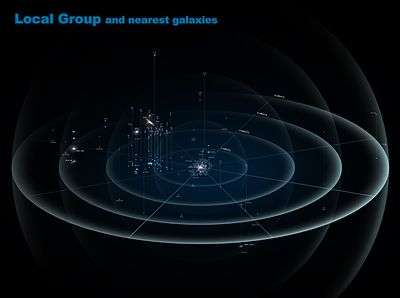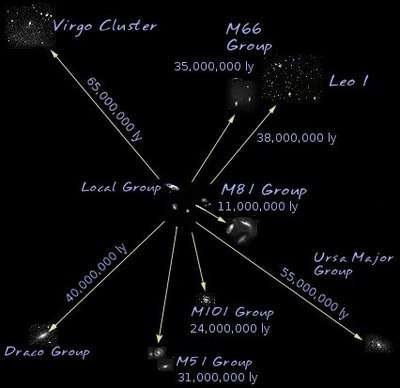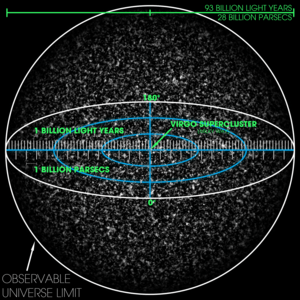Earth
Earth is the third planet from the Sun and the only astronomical object known to harbor life. According to radiometric dating estimation and other evidence, Earth formed over 4.5 billion years ago. Earth's gravity interacts with other objects in space, especially the Sun and the Moon, which is Earth's only natural satellite. Earth orbits around the Sun in 365.256 solar days, a period known as an Earth sidereal year. During this time, Earth rotates about its axis 366.256 times, that is, a sidereal year has 366.256 sidereal days.[n 6]
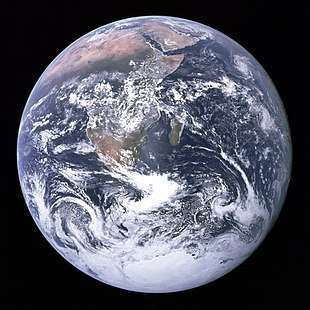 The Blue Marble, the first full-view photograph of the planet, was taken by Apollo 17 astronauts en route to the Moon in 1972 | |||||||||||||||||
| Designations | |||||||||||||||||
|---|---|---|---|---|---|---|---|---|---|---|---|---|---|---|---|---|---|
| Terra, Tellus, Gaia, Gaea, the World, the Globe | |||||||||||||||||
| Adjectives | Earthly, terrestrial, terran, tellurian | ||||||||||||||||
| Orbital characteristics | |||||||||||||||||
| Epoch J2000[n 1] | |||||||||||||||||
| Aphelion | 152100000 km[n 2] (94500000 mi) | ||||||||||||||||
| Perihelion | 147095000 km[n 2] (91401000 mi) | ||||||||||||||||
| 149598023 km[1] (92955902 mi) | |||||||||||||||||
| Eccentricity | 0.0167086[1] | ||||||||||||||||
| 365.256363004 d[2] (31558149.7635 s) | |||||||||||||||||
Average orbital speed | 29.78 km/s[3] (107200 km/h; 66600 mph) | ||||||||||||||||
| 358.617° | |||||||||||||||||
| Inclination |
| ||||||||||||||||
| −11.26064°[3] to J2000 ecliptic | |||||||||||||||||
| 2021-Jan-02 13:59[5] | |||||||||||||||||
| 114.20783°[3] | |||||||||||||||||
| Satellites |
| ||||||||||||||||
| Physical characteristics | |||||||||||||||||
Mean radius | 6371.0 km (3958.8 mi)[7] | ||||||||||||||||
Equatorial radius | 6378.1 km (3963.2 mi)[8][9] | ||||||||||||||||
Polar radius | 6356.8 km (3949.9 mi) | ||||||||||||||||
| Flattening | 0.0033528[11] 1/298.257222101 (ETRS89) | ||||||||||||||||
| Circumference |
| ||||||||||||||||
| Volume | 1.08321×1012 km3 (2.59876×1011 cu mi)[3] | ||||||||||||||||
| Mass | 5.97237×1024 kg (1.31668×1025 lb)[15] (3.0×10−6 M☉) | ||||||||||||||||
Mean density | 5.514 g/cm3 (0.1992 lb/cu in)[3] | ||||||||||||||||
| 9.80665 m/s2 (1 g; 32.1740 ft/s2)[16] | |||||||||||||||||
| 0.3307[17] | |||||||||||||||||
| 11.186 km/s[3] (40270 km/h; 25020 mph) | |||||||||||||||||
Sidereal rotation period | |||||||||||||||||
Equatorial rotation velocity | 0.4651 km/s[19] (1674.4 km/h; 1040.4 mph) | ||||||||||||||||
| 23.4392811°[2] | |||||||||||||||||
| Albedo | |||||||||||||||||
| |||||||||||||||||
| Atmosphere | |||||||||||||||||
Surface pressure | 101.325 kPa (at MSL) | ||||||||||||||||
| Composition by volume | |||||||||||||||||
Earth's axis of rotation is tilted with respect to its orbital plane, producing seasons on Earth. The gravitational interaction between Earth and the Moon causes tides, stabilizes Earth's orientation on its axis, and gradually slows its rotation. Earth is the densest planet in the Solar System and the largest and most massive of the four rocky planets.
Earth's outer layer (lithosphere) is divided into several rigid tectonic plates that migrate across the surface over many millions of years. About 29% of Earth's surface is land consisting of continents and islands. The remaining 71% is covered with water, mostly by oceans but also lakes, rivers and other fresh water, which all together constitute the hydrosphere. The majority of Earth's polar regions are covered in ice, including the Antarctic ice sheet and the sea ice of the Arctic ice pack. Earth's interior remains active with a solid iron inner core, a liquid outer core that generates Earth's magnetic field, and a convecting mantle that drives plate tectonics.
Within the first billion years of Earth's history, life appeared in the oceans and began to affect Earth's atmosphere and surface, leading to the proliferation of anaerobic and, later, aerobic organisms. Some geological evidence indicates that life may have arisen as early as 4.1 billion years ago. Since then, the combination of Earth's distance from the Sun, physical properties and geological history have allowed life to evolve and thrive. In the history of life on Earth, biodiversity has gone through long periods of expansion, occasionally punctuated by mass extinctions. Over 99% of all species that ever lived on Earth are extinct. Estimates of the number of species on Earth today vary widely; most species have not been described. Over 7.7 billion humans live on Earth and depend on its biosphere and natural resources for their survival.[24]
Etymology

The modern English word Earth developed, via Middle English,[n 7] from an Old English noun most often spelled eorðe.[25] It has cognates in every Germanic language, and their ancestral root has been reconstructed as *erþō. In its earliest attestation, the word eorðe was already being used to translate the many senses of Latin terra and Greek γῆ gē: the ground,[n 8] its soil,[n 9] dry land,[n 10] the human world,[n 11] the surface of the world (including the sea),[n 12] and the globe itself.[n 13] As with Roman Terra/Tellūs and Greek Gaia, Earth may have been a personified goddess in Germanic paganism: late Norse mythology included Jörð ('Earth'), a giantess often given as the mother of Thor.[34]
Historically, earth has been written in lowercase. From early Middle English, its definite sense as "the globe" was expressed as the earth. By Early Modern English, many nouns were capitalized, and the earth was also written the Earth, particularly when referenced along with other heavenly bodies. More recently, the name is sometimes simply given as Earth, by analogy with the names of the other planets, though earth and forms with the remain common.[25] House styles now vary: Oxford spelling recognizes the lowercase form as the most common, with the capitalized form an acceptable variant. Another convention capitalizes "Earth" when appearing as a name (e.g. "Earth's atmosphere") but writes it in lowercase when preceded by the (e.g. "the atmosphere of the earth"). It almost always appears in lowercase in colloquial expressions such as "what on earth are you doing?"[35]
Occasionally, the name Terra /ˈtɛrə/ is used in scientific writing and especially in science fiction to distinguish our inhabited planet from others,[36] while in poetry Tellus /ˈtɛləs/ has been used to denote personification of the Earth.[37] The Greek poetic name Gaea (Gæa) /ˈdʒiːə/ is rare, though the alternative spelling Gaia has become common due to the Gaia hypothesis, in which case its pronunciation is /ˈɡaɪə/ rather than the more Classical /ˈɡeɪə/.[38]
There are a number of adjectives for the planet Earth. From Earth itself comes earthly. From Latin Terra come Terran /ˈtɛrən/,[39] Terrestrial /təˈrɛstriəl/,[40] and (via French) Terrene /təˈriːn/,[41] and from Latin Tellus come Tellurian /tɛˈlʊəriən/[42] and, more rarely, Telluric and Tellural. From Greek Gaia and Gaea comes Gaian and Gaean.
An inhabitant of the Earth is an Earthling, a Terran, a Terrestrial, a Tellurian or, rarely, an Earthian.
Chronology
Formation
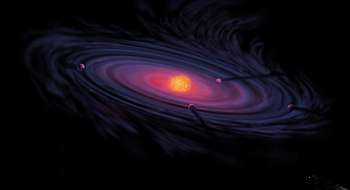
The oldest material found in the Solar System is dated to 4.5672±0.0006 billion years ago (BYA).[43] By 4.54±0.04 BYA[44] the primordial Earth had formed. The bodies in the Solar System formed and evolved with the Sun. In theory, a solar nebula partitions a volume out of a molecular cloud by gravitational collapse, which begins to spin and flatten into a circumstellar disk, and then the planets grow out of that disk with the Sun. A nebula contains gas, ice grains, and dust (including primordial nuclides). According to nebular theory, planetesimals formed by accretion, with the primordial Earth taking 10–20 million years (Mys) to form.[45]
A subject of research is the formation of the Moon, some 4.53 BYA.[46] A leading hypothesis is that it was formed by accretion from material loosed from Earth after a Mars-sized object, named Theia, hit Earth.[47] In this view, the mass of Theia was approximately 10 percent of Earth;[48] it hit Earth with a glancing blow and some of its mass merged with Earth.[49] Between approximately 4.1 and 3.8 BYA, numerous asteroid impacts during the Late Heavy Bombardment caused significant changes to the greater surface environment of the Moon and, by inference, to that of Earth.
Geological history

Earth's atmosphere and oceans were formed by volcanic activity and outgassing.[50] Water vapor from these sources condensed into the oceans, augmented by water and ice from asteroids, protoplanets, and comets.[51] In this model, atmospheric "greenhouse gases" kept the oceans from freezing when the newly forming Sun had only 70% of its current luminosity.[52] By 3.5 BYA, Earth's magnetic field was established, which helped prevent the atmosphere from being stripped away by the solar wind.[53]
A crust formed when the molten outer layer of Earth cooled to form a solid. The two models[54] that explain land mass propose either a steady growth to the present-day forms[55] or, more likely, a rapid growth[56] early in Earth history[57] followed by a long-term steady continental area.[58][59][60] Continents formed by plate tectonics, a process ultimately driven by the continuous loss of heat from Earth's interior. Over the period of hundreds of millions of years, the supercontinents have assembled and broken apart. Roughly 750 million years ago (MYA), one of the earliest known supercontinents, Rodinia, began to break apart. The continents later recombined to form Pannotia 600–540 MYA, then finally Pangaea, which also broke apart 180 MYA.[61]
The present pattern of ice ages began about 40 MYA,[62] and then intensified during the Pleistocene about 3 MYA.[63] High-latitude regions have since undergone repeated cycles of glaciation and thaw, repeating about every 40,000–100,000 years. The last continental glaciation ended 10,000 years ago.[64]
Origin of life and evolution
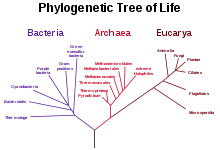
Chemical reactions led to the first self-replicating molecules about four billion years ago. A half billion years later, the last common ancestor of all current life arose.[65] The evolution of photosynthesis allowed the Sun's energy to be harvested directly by life forms. The resultant molecular oxygen (O
2) accumulated in the atmosphere and due to interaction with ultraviolet solar radiation, formed a protective ozone layer (O
3) in the upper atmosphere.[66] The incorporation of smaller cells within larger ones resulted in the development of complex cells called eukaryotes.[67] True multicellular organisms formed as cells within colonies became increasingly specialized. Aided by the absorption of harmful ultraviolet radiation by the ozone layer, life colonized Earth's surface.[68] Among the earliest fossil evidence for life is microbial mat fossils found in 3.48 billion-year-old sandstone in Western Australia,[69] biogenic graphite found in 3.7 billion-year-old metasedimentary rocks in Western Greenland,[70] and remains of biotic material found in 4.1 billion-year-old rocks in Western Australia.[71][72] The earliest direct evidence of life on Earth is contained in 3.45 billion-year-old Australian rocks showing fossils of microorganisms.[73][74]
During the Neoproterozoic, 750 to 580 MYA, much of Earth might have been covered in ice. This hypothesis has been termed "Snowball Earth", and it is of particular interest because it preceded the Cambrian explosion, when multicellular life forms significantly increased in complexity.[75] Following the Cambrian explosion, 535 MYA, there have been five mass extinctions.[76] The most recent such event was 66 MYA, when an asteroid impact triggered the extinction of the non-avian dinosaurs and other large reptiles, but spared some small animals such as mammals, which at the time resembled shrews. Mammalian life has diversified over the past 66 Mys, and several million years ago an African ape-like animal such as Orrorin tugenensis gained the ability to stand upright.[77] This facilitated tool use and encouraged communication that provided the nutrition and stimulation needed for a larger brain, which led to the evolution of humans. The development of agriculture, and then civilization, led to humans having an influence on Earth and the nature and quantity of other life forms that continues to this day.[78]
Future
Earth's expected long-term future is tied to that of the Sun. Over the next 1.1 billion years, solar luminosity will increase by 10%, and over the next 3.5 billion years by 40%.[79] Earth's increasing surface temperature will accelerate the inorganic carbon cycle, reducing CO
2 concentration to levels lethally low for plants (10 ppm for C4 photosynthesis) in approximately 100–900 million years.[80][81] The lack of vegetation will result in the loss of oxygen in the atmosphere, making animal life impossible.[82] About a billion years from now, all surface water will have disappeared[83] and the mean global temperature will reach 70 °C (158 °F).[82] Earth is expected to be habitable until the end of photosynthesis about 500 million years from now,[80] but if nitrogen is removed from the atmosphere, life may continue until a runaway greenhouse effect occurs 2.3 billion years from now.[81] Anthropogenic emissions are "probably insufficient" to cause a runaway greenhouse at current solar luminosity.[84] Even if the Sun were eternal and stable, 27% of the water in the modern oceans will descend to the mantle in one billion years, due to reduced steam venting from mid-ocean ridges.[85]
The Sun will evolve to become a red giant in about 5 billion years. Models predict that the Sun will expand to roughly 1 AU (150 million km; 93 million mi), about 250 times its present radius.[79][86] Earth's fate is less clear. As a red giant, the Sun will lose roughly 30% of its mass, so, without tidal effects, Earth will move to an orbit 1.7 AU (250 million km; 160 million mi) from the Sun when the star reaches its maximum radius. Most, if not all, remaining life will be destroyed by the Sun's increased luminosity (peaking at about 5,000 times its present level).[79] A 2008 simulation indicates that Earth's orbit will eventually decay due to tidal effects and drag, causing it to enter the Sun's atmosphere and be vaporized.[86]
Physical characteristics
Shape
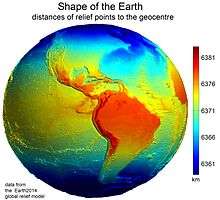
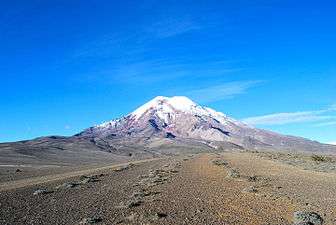
The shape of Earth is nearly spherical. There is a small flattening at the poles and bulging around the equator due to Earth's rotation.[90] To second order, Earth is approximately an oblate spheroid, whose equatorial diameter is 43 kilometres (27 mi) larger than the pole-to-pole diameter,[91] although the variation is less than 1% of the average radius of the Earth.
The point on the surface farthest from Earth's center of mass is the summit of the equatorial Chimborazo volcano in Ecuador (6,384.4 km or 3,967.1 mi).[92][93][94][95] The average diameter of the reference spheroid is 12,742 kilometres (7,918 mi). Local topography deviates from this idealized spheroid, although on a global scale these deviations are small compared to Earth's radius: the maximum deviation of only 0.17% is at the Mariana Trench (10,911 metres or 35,797 feet below local sea level), whereas Mount Everest (8,848 metres or 29,029 feet above local sea level) represents a deviation of 0.14%.[n 14]
In geodesy, the exact shape that Earth's oceans would adopt in the absence of land and perturbations such as tides and winds is called the geoid. More precisely, the geoid is the surface of gravitational equipotential at mean sea level.
Chemical composition
| Compound | Formula | Composition | |
|---|---|---|---|
| Continental | Oceanic | ||
| silica | SiO 2 |
60.6% | 48.6% |
| alumina | Al 2O 3 |
15.9% | 16.5% |
| lime | CaO | 6.41% | 12.3% |
| magnesia | MgO | 4.66% | 6.8% |
| iron oxide | FeOT | 6.71% | 6.2% |
| sodium oxide | Na 2O |
3.07% | 2.6% |
| potassium oxide | K 2O |
1.81% | 0.4% |
| titanium dioxide | TiO 2 |
0.72% | 1.4% |
| phosphorus pentoxide | P 2O 5 |
0.13% | 0.3% |
| manganese oxide | MnO | 0.10% | 1.4% |
| Total | 100.1% | 99.9% | |
Earth's mass is approximately 5.97×1024 kg (5,970 Yg). It is composed mostly of iron (32.1%), oxygen (30.1%), silicon (15.1%), magnesium (13.9%), sulphur (2.9%), nickel (1.8%), calcium (1.5%), and aluminum (1.4%), with the remaining 1.2% consisting of trace amounts of other elements. Due to mass segregation, the core region is estimated to be primarily composed of iron (88.8%), with smaller amounts of nickel (5.8%), sulphur (4.5%), and less than 1% trace elements.[99]
The most common rock constituents of the crust are nearly all oxides: chlorine, sulphur, and fluorine are the important exceptions to this and their total amount in any rock is usually much less than 1%. Over 99% of the crust is composed of 11 oxides, principally silica, alumina, iron oxides, lime, magnesia, potash and soda.[100][99][101]
Internal structure
Earth's interior, like that of the other terrestrial planets, is divided into layers by their chemical or physical (rheological) properties. The outer layer is a chemically distinct silicate solid crust, which is underlain by a highly viscous solid mantle. The crust is separated from the mantle by the Mohorovičić discontinuity. The thickness of the crust varies from about 6 kilometres (3.7 mi) under the oceans to 30–50 km (19–31 mi) for the continents. The crust and the cold, rigid, top of the upper mantle are collectively known as the lithosphere, and it is of the lithosphere that the tectonic plates are composed. Beneath the lithosphere is the asthenosphere, a relatively low-viscosity layer on which the lithosphere rides. Important changes in crystal structure within the mantle occur at 410 and 660 km (250 and 410 mi) below the surface, spanning a transition zone that separates the upper and lower mantle. Beneath the mantle, an extremely low viscosity liquid outer core lies above a solid inner core.[102] Earth's inner core might rotate at a slightly higher angular velocity than the remainder of the planet, advancing by 0.1–0.5° per year.[103] The radius of the inner core is about one fifth of that of Earth. Density increases with depth, as described in the table below.
 Earth cutaway from core to exosphere. Not to scale. | ||
|---|---|---|
| Depth[105] km |
Component layer | Density g/cm3 |
| 0–60 | Lithosphere[n 15] | — |
| 0–35 | Crust[n 16] | 2.2–2.9 |
| 35–660 | Upper mantle | 3.4–4.4 |
| 660-2890 | Lower Mantle | 3.4–5.6 |
| 100–700 | Asthenosphere | — |
| 2890–5100 | Outer core | 9.9–12.2 |
| 5100–6378 | Inner core | 12.8–13.1 |
Heat
Earth's internal heat comes from a combination of residual heat from planetary accretion (about 20%) and heat produced through radioactive decay (80%).[106] The major heat-producing isotopes within Earth are potassium-40, uranium-238, and thorium-232.[107] At the center, the temperature may be up to 6,000 °C (10,830 °F),[108] and the pressure could reach 360 GPa (52 million psi).[109] Because much of the heat is provided by radioactive decay, scientists postulate that early in Earth's history, before isotopes with short half-lives were depleted, Earth's heat production was much higher. At approximately 3 Gyr, twice the present-day heat would have been produced, increasing the rates of mantle convection and plate tectonics, and allowing the production of uncommon igneous rocks such as komatiites that are rarely formed today.[106][110]
| Isotope | Heat release W/kg isotope |
Half-life years |
Mean mantle concentration kg isotope/kg mantle |
Heat release W/kg mantle |
|---|---|---|---|---|
| 238U | 94.6×10−6 | 4.47×109 | 30.8×10−9 | 2.91×10−12 |
| 235U | 569×10−6 | 0.704×109 | 0.22×10−9 | 0.125×10−12 |
| 232Th | 26.4×10−6 | 14.0×109 | 124×10−9 | 3.27×10−12 |
| 40K | 29.2×10−6 | 1.25×109 | 36.9×10−9 | 1.08×10−12 |
The mean heat loss from Earth is 87 mW m−2, for a global heat loss of 4.42×1013 W.[112] A portion of the core's thermal energy is transported toward the crust by mantle plumes, a form of convection consisting of upwellings of higher-temperature rock. These plumes can produce hotspots and flood basalts.[113] More of the heat in Earth is lost through plate tectonics, by mantle upwelling associated with mid-ocean ridges. The final major mode of heat loss is through conduction through the lithosphere, the majority of which occurs under the oceans because the crust there is much thinner than that of the continents.[114]
Tectonic plates
.svg.png) | |
| Plate name | Area 106 km2 |
|---|---|
| 103.3 | |
| 78.0 | |
| 75.9 | |
| 67.8 | |
| 60.9 | |
| 47.2 | |
| 43.6 | |
Earth's mechanically rigid outer layer, the lithosphere, is divided into tectonic plates. These plates are rigid segments that move relative to each other at one of three boundaries types: At convergent boundaries, two plates come together; at divergent boundaries, two plates are pulled apart; and at transform boundaries, two plates slide past one another laterally. Along these plate boundaries, earthquakes, volcanic activity, mountain-building, and oceanic trench formation can occur.[116] The tectonic plates ride on top of the asthenosphere, the solid but less-viscous part of the upper mantle that can flow and move along with the plates.[117]

As the tectonic plates migrate, oceanic crust is subducted under the leading edges of the plates at convergent boundaries. At the same time, the upwelling of mantle material at divergent boundaries creates mid-ocean ridges. The combination of these processes recycles the oceanic crust back into the mantle. Due to this recycling, most of the ocean floor is less than 100 Ma old. The oldest oceanic crust is located in the Western Pacific and is estimated to be 200 Ma old.[118][119] By comparison, the oldest dated continental crust is 4,030 Ma.[120]
The seven major plates are the Pacific, North American, Eurasian, African, Antarctic, Indo-Australian, and South American. Other notable plates include the Arabian Plate, the Caribbean Plate, the Nazca Plate off the west coast of South America and the Scotia Plate in the southern Atlantic Ocean. The Australian Plate fused with the Indian Plate between 50 and 55 Mya. The fastest-moving plates are the oceanic plates, with the Cocos Plate advancing at a rate of 75 mm/a (3.0 in/year)[121] and the Pacific Plate moving 52–69 mm/a (2.0–2.7 in/year). At the other extreme, the slowest-moving plate is the Eurasian Plate, progressing at a typical rate of 21 mm/a (0.83 in/year).[122]
Surface
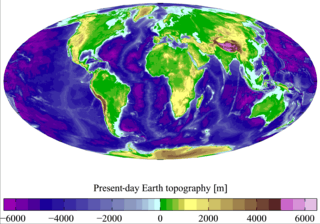
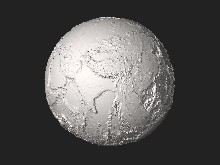
The total surface area of Earth is about 510 million km2 (197 million sq mi).[13] Of this, 70.8%,[13] or 361.13 million km2 (139.43 million sq mi), is below sea level and covered by ocean water.[123] Below the ocean's surface are much of the continental shelf, mountains, volcanoes,[91] oceanic trenches, submarine canyons, oceanic plateaus, abyssal plains, and a globe-spanning mid-ocean ridge system. The remaining 29.2%, or 148.94 million km2 (57.51 million sq mi), not covered by water has terrain that varies greatly from place to place and consists of mountains, deserts, plains, plateaus, and other landforms. Tectonics and erosion, volcanic eruptions, flooding, weathering, glaciation, the growth of coral reefs, and meteorite impacts are among the processes that constantly reshape Earth's surface over geological time.[124][125]
The continental crust consists of lower density material such as the igneous rocks granite and andesite. Less common is basalt, a denser volcanic rock that is the primary constituent of the ocean floors.[126] Sedimentary rock is formed from the accumulation of sediment that becomes buried and compacted together. Nearly 75% of the continental surfaces are covered by sedimentary rocks, although they form about 5% of the crust.[127] The third form of rock material found on Earth is metamorphic rock, which is created from the transformation of pre-existing rock types through high pressures, high temperatures, or both. The most abundant silicate minerals on Earth's surface include quartz, feldspars, amphibole, mica, pyroxene and olivine.[128] Common carbonate minerals include calcite (found in limestone) and dolomite.[129]
The elevation of the land surface varies from the low point of −418 m (−1,371 ft) at the Dead Sea, to a maximum altitude of 8,848 m (29,029 ft) at the top of Mount Everest. The mean height of land above sea level is about 797 m (2,615 ft).[130]
The pedosphere is the outermost layer of Earth's continental surface and is composed of soil and subject to soil formation processes. The total arable land is 10.9% of the land surface, with 1.3% being permanent cropland.[131][132] Close to 40% of Earth's land surface is used for agriculture, or an estimated 16.7 million km2 (6.4 million sq mi) of cropland and 33.5 million km2 (12.9 million sq mi) of pastureland.[133]
Hydrosphere
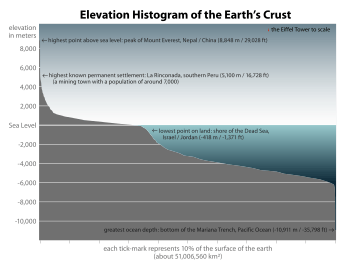
The abundance of water on Earth's surface is a unique feature that distinguishes the "Blue Planet" from other planets in the Solar System. Earth's hydrosphere consists chiefly of the oceans, but technically includes all water surfaces in the world, including inland seas, lakes, rivers, and underground waters down to a depth of 2,000 m (6,600 ft). The deepest underwater location is Challenger Deep of the Mariana Trench in the Pacific Ocean with a depth of 10,911.4 m (35,799 ft).[n 18][134]
The mass of the oceans is approximately 1.35×1018 metric tons or about 1/4400 of Earth's total mass. The oceans cover an area of 361.8 million km2 (139.7 million sq mi) with a mean depth of 3,682 m (12,080 ft), resulting in an estimated volume of 1.332 billion km3 (320 million cu mi).[135] If all of Earth's crustal surface were at the same elevation as a smooth sphere, the depth of the resulting world ocean would be 2.7 to 2.8 km (1.68 to 1.74 mi).[136][137]
About 97.5% of the water is saline; the remaining 2.5% is fresh water. Most fresh water, about 68.7%, is present as ice in ice caps and glaciers.[138]
The average salinity of Earth's oceans is about 35 grams of salt per kilogram of sea water (3.5% salt).[139] Most of this salt was released from volcanic activity or extracted from cool igneous rocks.[140] The oceans are also a reservoir of dissolved atmospheric gases, which are essential for the survival of many aquatic life forms.[141] Sea water has an important influence on the world's climate, with the oceans acting as a large heat reservoir.[142] Shifts in the oceanic temperature distribution can cause significant weather shifts, such as the El Niño–Southern Oscillation.[143]
Atmosphere
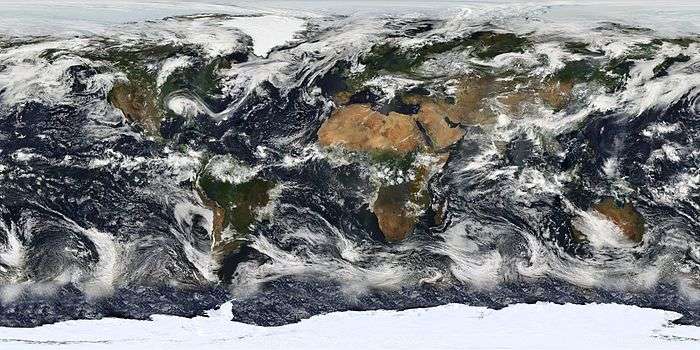
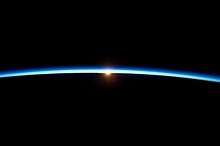
The atmospheric pressure at Earth's sea level averages 101.325 kPa (14.696 psi),[144] with a scale height of about 8.5 km (5.3 mi).[3] A dry atmosphere is composed of 78.084% nitrogen, 20.946% oxygen, 0.934% argon, and trace amounts of carbon dioxide and other gaseous molecules.[144] Water vapor content varies between 0.01% and 4%[144] but averages about 1%.[3] The height of the troposphere varies with latitude, ranging between 8 km (5 mi) at the poles to 17 km (11 mi) at the equator, with some variation resulting from weather and seasonal factors.[145]
Earth's biosphere has significantly altered its atmosphere. Oxygenic photosynthesis evolved 2.7 Gya, forming the primarily nitrogen–oxygen atmosphere of today.[66] This change enabled the proliferation of aerobic organisms and, indirectly, the formation of the ozone layer due to the subsequent conversion of atmospheric O
2 into O
3. The ozone layer blocks ultraviolet solar radiation, permitting life on land.[146] Other atmospheric functions important to life include transporting water vapor, providing useful gases, causing small meteors to burn up before they strike the surface, and moderating temperature.[147] This last phenomenon is known as the greenhouse effect: trace molecules within the atmosphere serve to capture thermal energy emitted from the ground, thereby raising the average temperature. Water vapor, carbon dioxide, methane, nitrous oxide, and ozone are the primary greenhouse gases in the atmosphere. Without this heat-retention effect, the average surface temperature would be −18 °C (0 °F), in contrast to the current +15 °C (59 °F),[148] and life on Earth probably would not exist in its current form.[149] In May 2017, glints of light, seen as twinkling from an orbiting satellite a million miles away, were found to be reflected light from ice crystals in the atmosphere.[150][151]
Weather and climate
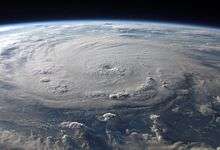
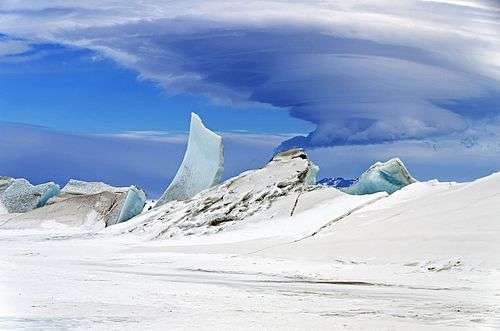
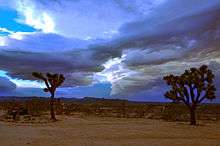
Earth's atmosphere has no definite boundary, slowly becoming thinner and fading into outer space. Three-quarters of the atmosphere's mass is contained within the first 11 km (6.8 mi) of the surface. This lowest layer is called the troposphere. Energy from the Sun heats this layer, and the surface below, causing expansion of the air. This lower-density air then rises and is replaced by cooler, higher-density air. The result is atmospheric circulation that drives the weather and climate through redistribution of thermal energy.[152]
The primary atmospheric circulation bands consist of the trade winds in the equatorial region below 30° latitude and the westerlies in the mid-latitudes between 30° and 60°.[153] Ocean currents are also important factors in determining climate, particularly the thermohaline circulation that distributes thermal energy from the equatorial oceans to the polar regions.[154]
Water vapor generated through surface evaporation is transported by circulatory patterns in the atmosphere. When atmospheric conditions permit an uplift of warm, humid air, this water condenses and falls to the surface as precipitation.[152] Most of the water is then transported to lower elevations by river systems and usually returned to the oceans or deposited into lakes. This water cycle is a vital mechanism for supporting life on land and is a primary factor in the erosion of surface features over geological periods. Precipitation patterns vary widely, ranging from several meters of water per year to less than a millimeter. Atmospheric circulation, topographic features, and temperature differences determine the average precipitation that falls in each region.[155]
The amount of solar energy reaching Earth's surface decreases with increasing latitude. At higher latitudes, the sunlight reaches the surface at lower angles, and it must pass through thicker columns of the atmosphere. As a result, the mean annual air temperature at sea level decreases by about 0.4 °C (0.7 °F) per degree of latitude from the equator.[156] Earth's surface can be subdivided into specific latitudinal belts of approximately homogeneous climate. Ranging from the equator to the polar regions, these are the tropical (or equatorial), subtropical, temperate and polar climates.[157]
This latitudinal rule has several anomalies:
- Proximity to oceans moderates the climate. For example, the Scandinavian Peninsula has more moderate climate than similarly northern latitudes of northern Canada.
- The wind enables this moderating effect. The windward side of a land mass experiences more moderation than the leeward side. In the Northern Hemisphere, the prevailing wind is west-to-east, and western coasts tend to be milder than eastern coasts. This is seen in Eastern North America and Western Europe, where rough continental climates appear on the east coast on parallels with mild climates on the other side of the ocean.[158] In the Southern Hemisphere, the prevailing wind is east-to-west, and the eastern coasts are milder.
- The distance from Earth to the Sun varies. Earth is closest to the Sun (at perihelion) in January, which is summer in the Southern Hemisphere. It is furthest away (at aphelion) in July, which is summer in the Northern Hemisphere, and only 93.55% of the solar radiation from the Sun falls on a given square area of land than at perihelion. Despite this, there are larger land masses in the Northern Hemisphere, which are easier to heat than the seas. Consequently, summers are 2.3 °C (4 °F) warmer in the Northern Hemisphere than in the Southern Hemisphere under similar conditions.[159]
- The climate is colder at high altitudes than at sea level because of the decreased air density.
The commonly used Köppen climate classification system has five broad groups (humid tropics, arid, humid middle latitudes, continental and cold polar), which are further divided into more specific subtypes.[153] The Köppen system rates regions of terrain based on observed temperature and precipitation.
The highest air temperature ever measured on Earth was 56.7 °C (134.1 °F) in Furnace Creek, California, in Death Valley, in 1913.[160] The lowest air temperature ever directly measured on Earth was −89.2 °C (−128.6 °F) at Vostok Station in 1983,[161] but satellites have used remote sensing to measure temperatures as low as −94.7 °C (−138.5 °F) in East Antarctica.[162] These temperature records are only measurements made with modern instruments from the 20th century onwards and likely do not reflect the full range of temperature on Earth.
Upper atmosphere

Above the troposphere, the atmosphere is usually divided into the stratosphere, mesosphere, and thermosphere.[147] Each layer has a different lapse rate, defining the rate of change in temperature with height. Beyond these, the exosphere thins out into the magnetosphere, where the geomagnetic fields interact with the solar wind.[163] Within the stratosphere is the ozone layer, a component that partially shields the surface from ultraviolet light and thus is important for life on Earth. The Kármán line, defined as 100 km above Earth's surface, is a working definition for the boundary between the atmosphere and outer space.[164]
Thermal energy causes some of the molecules at the outer edge of the atmosphere to increase their velocity to the point where they can escape from Earth's gravity. This causes a slow but steady loss of the atmosphere into space. Because unfixed hydrogen has a low molecular mass, it can achieve escape velocity more readily, and it leaks into outer space at a greater rate than other gases.[165] The leakage of hydrogen into space contributes to the shifting of Earth's atmosphere and surface from an initially reducing state to its current oxidizing one. Photosynthesis provided a source of free oxygen, but the loss of reducing agents such as hydrogen is thought to have been a necessary precondition for the widespread accumulation of oxygen in the atmosphere.[166] Hence the ability of hydrogen to escape from the atmosphere may have influenced the nature of life that developed on Earth.[167] In the current, oxygen-rich atmosphere most hydrogen is converted into water before it has an opportunity to escape. Instead, most of the hydrogen loss comes from the destruction of methane in the upper atmosphere.[168]
Gravitational field
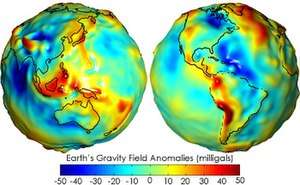
The gravity of Earth is the acceleration that is imparted to objects due to the distribution of mass within Earth. Near Earth's surface, gravitational acceleration is approximately 9.8 m/s2 (32 ft/s2). Local differences in topography, geology, and deeper tectonic structure cause local and broad, regional differences in Earth's gravitational field, known as gravity anomalies.[169]
Magnetic field
The main part of Earth's magnetic field is generated in the core, the site of a dynamo process that converts the kinetic energy of thermally and compositionally driven convection into electrical and magnetic field energy. The field extends outwards from the core, through the mantle, and up to Earth's surface, where it is, approximately, a dipole. The poles of the dipole are located close to Earth's geographic poles. At the equator of the magnetic field, the magnetic-field strength at the surface is 3.05×10−5 T, with a magnetic dipole moment of 7.79×1022 Am2 at epoch 2000, decreasing nearly 6% per century.[170] The convection movements in the core are chaotic; the magnetic poles drift and periodically change alignment. This causes secular variation of the main field and field reversals at irregular intervals averaging a few times every million years. The most recent reversal occurred approximately 700,000 years ago.[171][172]
Magnetosphere
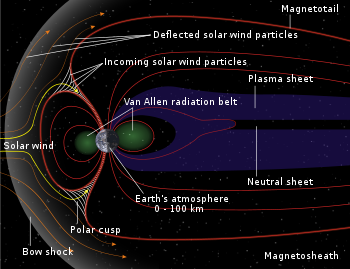
The extent of Earth's magnetic field in space defines the magnetosphere. Ions and electrons of the solar wind are deflected by the magnetosphere; solar wind pressure compresses the dayside of the magnetosphere, to about 10 Earth radii, and extends the nightside magnetosphere into a long tail.[173] Because the velocity of the solar wind is greater than the speed at which waves propagate through the solar wind, a supersonic bow shock precedes the dayside magnetosphere within the solar wind.[174] Charged particles are contained within the magnetosphere; the plasmasphere is defined by low-energy particles that essentially follow magnetic field lines as Earth rotates;[175][176] the ring current is defined by medium-energy particles that drift relative to the geomagnetic field, but with paths that are still dominated by the magnetic field,[177] and the Van Allen radiation belt are formed by high-energy particles whose motion is essentially random, but otherwise contained by the magnetosphere.[173][178]
During magnetic storms and substorms, charged particles can be deflected from the outer magnetosphere and especially the magnetotail, directed along field lines into Earth's ionosphere, where atmospheric atoms can be excited and ionized, causing the aurora.[179]
Orbit and rotation
Rotation
.gif)
Earth's rotation period relative to the Sun—its mean solar day—is 86,400 seconds of mean solar time (86,400.0025 SI seconds).[180] Because Earth's solar day is now slightly longer than it was during the 19th century due to tidal deceleration, each day varies between 0 and 2 SI ms longer.[181][182]
Earth's rotation period relative to the fixed stars, called its stellar day by the International Earth Rotation and Reference Systems Service (IERS), is 86,164.0989 seconds of mean solar time (UT1), or 23h 56m 4.0989s.[2][n 19] Earth's rotation period relative to the precessing or moving mean March equinox, misnamed its sidereal day, is 86,164.0905 seconds of mean solar time (UT1) (23h 56m 4.0905s).[2] Thus the sidereal day is shorter than the stellar day by about 8.4 ms.[183] The length of the mean solar day in SI seconds is available from the IERS for the periods 1623–2005[184] and 1962–2005.[185]
Apart from meteors within the atmosphere and low-orbiting satellites, the main apparent motion of celestial bodies in Earth's sky is to the west at a rate of 15°/h = 15'/min. For bodies near the celestial equator, this is equivalent to an apparent diameter of the Sun or the Moon every two minutes; from Earth's surface, the apparent sizes of the Sun and the Moon are approximately the same.[186][187]
Orbit

Earth orbits the Sun at an average distance of about 150 million km (93 million mi) every 365.2564 mean solar days, or one sidereal year. This gives an apparent movement of the Sun eastward with respect to the stars at a rate of about 1°/day, which is one apparent Sun or Moon diameter every 12 hours. Due to this motion, on average it takes 24 hours—a solar day—for Earth to complete a full rotation about its axis so that the Sun returns to the meridian. The orbital speed of Earth averages about 29.78 km/s (107,200 km/h; 66,600 mph), which is fast enough to travel a distance equal to Earth's diameter, about 12,742 km (7,918 mi), in seven minutes, and the distance to the Moon, 384,000 km (239,000 mi), in about 3.5 hours.[3]
The Moon and Earth orbit a common barycenter every 27.32 days relative to the background stars. When combined with the Earth–Moon system's common orbit around the Sun, the period of the synodic month, from new moon to new moon, is 29.53 days. Viewed from the celestial north pole, the motion of Earth, the Moon, and their axial rotations are all counterclockwise. Viewed from a vantage point above the north poles of both the Sun and Earth, Earth orbits in a counterclockwise direction about the Sun. The orbital and axial planes are not precisely aligned: Earth's axis is tilted some 23.44 degrees from the perpendicular to the Earth–Sun plane (the ecliptic), and the Earth–Moon plane is tilted up to ±5.1 degrees against the Earth–Sun plane. Without this tilt, there would be an eclipse every two weeks, alternating between lunar eclipses and solar eclipses.[3][189]
The Hill sphere, or the sphere of gravitational influence, of Earth is about 1.5 million km (930,000 mi) in radius.[190][n 20] This is the maximum distance at which Earth's gravitational influence is stronger than the more distant Sun and planets. Objects must orbit Earth within this radius, or they can become unbound by the gravitational perturbation of the Sun.
Earth, along with the Solar System, is situated in the Milky Way and orbits about 28,000 light-years from its center. It is about 20 light-years above the galactic plane in the Orion Arm.[191]
Axial tilt and seasons

The axial tilt of Earth is approximately 23.439281°[2] with the axis of its orbit plane, always pointing towards the Celestial Poles. Due to Earth's axial tilt, the amount of sunlight reaching any given point on the surface varies over the course of the year. This causes the seasonal change in climate, with summer in the Northern Hemisphere occurring when the Tropic of Cancer is facing the Sun, and winter taking place when the Tropic of Capricorn in the Southern Hemisphere faces the Sun. During the summer, the day lasts longer, and the Sun climbs higher in the sky. In winter, the climate becomes cooler and the days shorter. In northern temperate latitudes, the Sun rises north of true east during the summer solstice, and sets north of true west, reversing in the winter. The Sun rises south of true east in the summer for the southern temperate zone and sets south of true west.
Above the Arctic Circle, an extreme case is reached where there is no daylight at all for part of the year, up to six months at the North Pole itself, a polar night. In the Southern Hemisphere, the situation is exactly reversed, with the South Pole oriented opposite the direction of the North Pole. Six months later, this pole will experience a midnight sun, a day of 24 hours, again reversing with the South Pole.
By astronomical convention, the four seasons can be determined by the solstices—the points in the orbit of maximum axial tilt toward or away from the Sun—and the equinoxes, when Earth's rotational axis is aligned with its orbital axis. In the Northern Hemisphere, winter solstice currently occurs around 21 December; summer solstice is near 21 June, spring equinox is around 20 March and autumnal equinox is about 22 or 23 September. In the Southern Hemisphere, the situation is reversed, with the summer and winter solstices exchanged and the spring and autumnal equinox dates swapped.[192]
The angle of Earth's axial tilt is relatively stable over long periods of time. Its axial tilt does undergo nutation; a slight, irregular motion with a main period of 18.6 years.[193] The orientation (rather than the angle) of Earth's axis also changes over time, precessing around in a complete circle over each 25,800 year cycle; this precession is the reason for the difference between a sidereal year and a tropical year. Both of these motions are caused by the varying attraction of the Sun and the Moon on Earth's equatorial bulge. The poles also migrate a few meters across Earth's surface. This polar motion has multiple, cyclical components, which collectively are termed quasiperiodic motion. In addition to an annual component to this motion, there is a 14-month cycle called the Chandler wobble. Earth's rotational velocity also varies in a phenomenon known as length-of-day variation.[194]
In modern times, Earth's perihelion occurs around 3 January, and its aphelion around 4 July. These dates change over time due to precession and other orbital factors, which follow cyclical patterns known as Milankovitch cycles. The changing Earth–Sun distance causes an increase of about 6.9%[n 21] in solar energy reaching Earth at perihelion relative to aphelion. Because the Southern Hemisphere is tilted toward the Sun at about the same time that Earth reaches the closest approach to the Sun, the Southern Hemisphere receives slightly more energy from the Sun than does the northern over the course of a year. This effect is much less significant than the total energy change due to the axial tilt, and most of the excess energy is absorbed by the higher proportion of water in the Southern Hemisphere.[195]
A study from 2016 suggested that Planet Nine tilted all the planets of the Solar System, including Earth, by about six degrees.[196]
Habitability
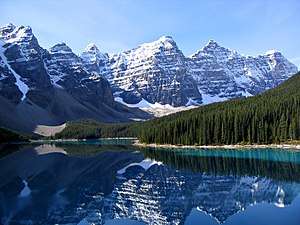
A planet that can sustain life is termed habitable, even if life did not originate there. Earth provides liquid water—an environment where complex organic molecules can assemble and interact, and sufficient energy to sustain metabolism.[197] The distance of Earth from the Sun, as well as its orbital eccentricity, rate of rotation, axial tilt, geological history, sustaining atmosphere, and magnetic field all contribute to the current climatic conditions at the surface.[198]
Biosphere
A planet's life forms inhabit ecosystems, whose total is sometimes said to form a "biosphere".[199] Earth's biosphere is thought to have begun evolving about 3.5 Gya.[66] The biosphere is divided into a number of biomes, inhabited by broadly similar plants and animals.[200] On land, biomes are separated primarily by differences in latitude, height above sea level and humidity. Terrestrial biomes lying within the Arctic or Antarctic Circles, at high altitudes or in extremely arid areas are relatively barren of plant and animal life; species diversity reaches a peak in humid lowlands at equatorial latitudes.[201]
In July 2016, scientists reported identifying a set of 355 genes from the last universal common ancestor (LUCA) of all organisms living on Earth.[202]
Natural resources and land use
| Land use | Mha |
|---|---|
| Cropland | 1,510–1,611 |
| Pastures | 2,500–3,410 |
| Natural forests | 3,143–3,871 |
| Planted forests | 126–215 |
| Urban areas | 66–351 |
| Unused, productive land | 356–445 |
Earth has resources that have been exploited by humans.[204] Those termed non-renewable resources, such as fossil fuels, only renew over geological timescales.[205]
Large deposits of fossil fuels are obtained from Earth's crust, consisting of coal, petroleum, and natural gas.[206] These deposits are used by humans both for energy production and as feedstock for chemical production.[207] Mineral ore bodies have also been formed within the crust through a process of ore genesis, resulting from actions of magmatism, erosion, and plate tectonics.[208] These bodies form concentrated sources for many metals and other useful elements.
Earth's biosphere produces many useful biological products for humans, including food, wood, pharmaceuticals, oxygen, and the recycling of many organic wastes. The land-based ecosystem depends upon topsoil and fresh water, and the oceanic ecosystem depends upon dissolved nutrients washed down from the land.[209] In 1980, 50.53 million km2 (19.51 million sq mi) of Earth's land surface consisted of forest and woodlands, 67.88 million km2 (26.21 million sq mi) was grasslands and pasture, and 15.01 million km2 (5.80 million sq mi) was cultivated as croplands.[210] The estimated amount of irrigated land in 1993 was 2,481,250 km2 (958,020 sq mi).[14] Humans also live on the land by using building materials to construct shelters.
Natural and environmental hazards
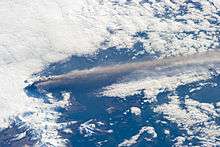
Large areas of Earth's surface are subject to extreme weather such as tropical cyclones, hurricanes, or typhoons that dominate life in those areas. From 1980 to 2000, these events caused an average of 11,800 human deaths per year.[211] Many places are subject to earthquakes, landslides, tsunamis, volcanic eruptions, tornadoes, sinkholes, blizzards, floods, droughts, wildfires, and other calamities and disasters.
Many localized areas are subject to human-made pollution of the air and water, acid rain and toxic substances, loss of vegetation (overgrazing, deforestation, desertification), loss of wildlife, species extinction, soil degradation, soil depletion and erosion.
There is a scientific consensus linking human activities to global warming due to industrial carbon dioxide emissions. This is predicted to produce changes such as the melting of glaciers and ice sheets, more extreme temperature ranges, significant changes in weather and a global rise in average sea levels.[212]
Human geography
Cartography, the study and practice of map-making, and geography, the study of the lands, features, inhabitants and phenomena on Earth, have historically been the disciplines devoted to depicting Earth. Surveying, the determination of locations and distances, and to a lesser extent navigation, the determination of position and direction, have developed alongside cartography and geography, providing and suitably quantifying the requisite information.
Earth's human population reached approximately seven billion on 31 October 2011.[214] Projections indicate that the world's human population will reach 9.2 billion in 2050.[215] Most of the growth is expected to take place in developing nations. Human population density varies widely around the world, but a majority live in Asia. By 2020, 60% of the world's population is expected to be living in urban, rather than rural, areas.[216]
68% of the land mass of the world is in the northern hemisphere.[217] Partly due to the predominance of land mass, 90% of humans live in the northern hemisphere.[218]
It is estimated that one-eighth of Earth's surface is suitable for humans to live on – three-quarters of Earth's surface is covered by oceans, leaving one-quarter as land. Half of that land area is desert (14%),[219] high mountains (27%),[220] or other unsuitable terrains. The northernmost permanent settlement in the world is Alert, on Ellesmere Island in Nunavut, Canada.[221] (82°28′N) The southernmost is the Amundsen–Scott South Pole Station, in Antarctica, almost exactly at the South Pole. (90°S)
States claim the planet's entire land surface, except for parts of Antarctica and a few other unclaimed areas. Earth has never had a planetwide government, but the United Nations is the leading worldwide intergovernmental organization.
The first human to orbit Earth was Yuri Gagarin on 12 April 1961.[222] In total, about 487 people have visited outer space and reached orbit as of 30 July 2010, and, of these, twelve have walked on the Moon.[223][224][225] Normally, the only humans in space are those on the International Space Station. The station's crew, made up of six people, is usually replaced every six months.[226] The farthest that humans have traveled from Earth is 400,171 km (248,655 mi), achieved during the Apollo 13 mission in 1970.[227]
Moon
 Full moon as seen from Earth's Northern Hemisphere | |
| Diameter | 3,474.8 km |
| Mass | 7.349×1022 kg |
| Semi-major axis | 384,400 km |
| Orbital period | 27d 7h 43.7m |
The Moon is a relatively large, terrestrial, planet-like natural satellite, with a diameter about one-quarter of Earth's. It is the largest moon in the Solar System relative to the size of its planet, although Charon is larger relative to the dwarf planet Pluto. The natural satellites of other planets are also referred to as "moons", after Earth's.
The gravitational attraction between Earth and the Moon causes tides on Earth. The same effect on the Moon has led to its tidal locking: its rotation period is the same as the time it takes to orbit Earth. As a result, it always presents the same face to the planet. As the Moon orbits Earth, different parts of its face are illuminated by the Sun, leading to the lunar phases; the dark part of the face is separated from the light part by the solar terminator.
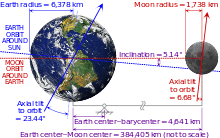
Due to their tidal interaction, the Moon recedes from Earth at the rate of approximately 38 mm/a (1.5 in/year). Over millions of years, these tiny modifications—and the lengthening of Earth's day by about 23 µs/yr—add up to significant changes.[228] During the Devonian period, for example, (approximately 410 Mya) there were 400 days in a year, with each day lasting 21.8 hours.[229]
The Moon may have dramatically affected the development of life by moderating the planet's climate. Paleontological evidence and computer simulations show that Earth's axial tilt is stabilized by tidal interactions with the Moon.[230] Some theorists think that without this stabilization against the torques applied by the Sun and planets to Earth's equatorial bulge, the rotational axis might be chaotically unstable, exhibiting chaotic changes over millions of years, as appears to be the case for Mars.[231]
Viewed from Earth, the Moon is just far enough away to have almost the same apparent-sized disk as the Sun. The angular size (or solid angle) of these two bodies match because, although the Sun's diameter is about 400 times as large as the Moon's, it is also 400 times more distant.[187] This allows total and annular solar eclipses to occur on Earth.
The most widely accepted theory of the Moon's origin, the giant-impact hypothesis, states that it formed from the collision of a Mars-size protoplanet called Theia with the early Earth. This hypothesis explains (among other things) the Moon's relative lack of iron and volatile elements and the fact that its composition is nearly identical to that of Earth's crust.[49]
Asteroids and artificial satellites

Earth has at least five co-orbital asteroids, including 3753 Cruithne and 2002 AA29.[232][233] A trojan asteroid companion, 2010 TK7, is librating around the leading Lagrange triangular point, L4, in Earth's orbit around the Sun.[234][235]
The tiny near-Earth asteroid 2006 RH120 makes close approaches to the Earth–Moon system roughly every twenty years. During these approaches, it can orbit Earth for brief periods of time.[236]
As of April 2018, there are 1,886 operational, human-made satellites orbiting Earth.[6] There are also inoperative satellites, including Vanguard 1, the oldest satellite currently in orbit, and over 16,000 pieces of tracked space debris.[n 3] Earth's largest artificial satellite is the International Space Station.
Cultural and historical viewpoint
The standard astronomical symbol of Earth consists of a cross circumscribed by a circle, ![]()
Human cultures have developed many views of the planet.[238] Earth is sometimes personified as a deity. In many cultures it is a mother goddess that is also the primary fertility deity,[239] and by the mid-20th century, the Gaia Principle compared Earth's environments and life as a single self-regulating organism leading to broad stabilization of the conditions of habitability.[240][241][242] Creation myths in many religions involve the creation of Earth by a supernatural deity or deities.[239]
The Hindu Vedas (1500–900 BC) refer to the Earth as Bhūgola (भूगोल), which comes from Bhū (earth, ground) and Gola (ball, sphere, globe). It means the "globe of earth". There is no direct evidence that the Hindus of that time knew that the Earth was sphere-shaped, but this name has been used extensively since the inception of the Vedas.
Scientific investigation has resulted in several culturally transformative shifts in people's view of the planet. Initial belief in a flat Earth was gradually displaced in the Greek colonies of southern Italy during the late 6th century BC by the idea of spherical Earth,[243][244][245] which was attributed to both the philosophers Pythagoras and Parmenides.[244][245] By the end of the 5th century BC, the sphericity of Earth was universally accepted among Greek intellectuals.[246] Earth was generally believed to be the center of the universe until the 16th century, when scientists first conclusively demonstrated that it was a moving object, comparable to the other planets in the Solar System.[247] Due to the efforts of influential Christian scholars and clerics such as James Ussher, who sought to determine the age of Earth through analysis of genealogies in Scripture, Westerners before the 19th century generally believed Earth to be a few thousand years old at most. It was only during the 19th century that geologists realized Earth's age was at least many millions of years.[248]
Lord Kelvin used thermodynamics to estimate the age of Earth to be between 20 million and 400 million years in 1864, sparking a vigorous debate on the subject; it was only when radioactivity and radioactive dating were discovered in the late 19th and early 20th centuries that a reliable mechanism for determining Earth's age was established, proving the planet to be billions of years old.[249][250] The perception of Earth shifted again in the 20th century when humans first viewed it from orbit, and especially with photographs of Earth returned by the Apollo program.[251][252][253]
See also
Notes
- All astronomical quantities vary, both secularly and periodically. The quantities given are the values at the instant J2000.0 of the secular variation, ignoring all periodic variations.
- aphelion = a × (1 + e); perihelion = a × (1 – e), where a is the semi-major axis and e is the eccentricity. The difference between Earth's perihelion and aphelion is 5 million kilometers.
- As of 4 January 2018, the United States Strategic Command tracked a total of 18,835 artificial objects, mostly debris. See: Anz-Meador, Phillip; Shoots, Debi, eds. (February 2018). "Satellite Box Score" (PDF). Orbital Debris Quarterly News. 22 (1): 12. Retrieved 18 April 2018.
- Earth's circumference is almost exactly 40,000 km because the metre was calibrated on this measurement—more specifically, 1/10-millionth of the distance between the poles and the equator.
- Due to natural fluctuations, ambiguities surrounding ice shelves, and mapping conventions for vertical datums, exact values for land and ocean coverage are not meaningful. Based on data from the Vector Map and Global Landcover Archived 26 March 2015 at the Wayback Machine datasets, extreme values for coverage of lakes and streams are 0.6% and 1.0% of Earth's surface. The ice shields of Antarctica and Greenland are counted as land, even though much of the rock that supports them lies below sea level.
- The number of solar days in a year is one less than the number of sidereal days (the time it takes the Earth to revolve exactly 360 degrees around its axis) because a solar day is about 236 seconds longer than a sidereal day. Over a year, this discrepancy adds up to a full sidereal day.
- Middle English spellings include eorþe, erþe, erde, and erthe.[25]
- As in Beowulf (1531–33):
Wearp ða wundelmæl wrættum gebunden
yrre oretta, þæt hit on eorðan læg,
stið ond stylecg.[25][26]
"He threw the artfully-wound sword so that it lay upon the earth, firm and sharp-edged."[26] - As in the Old English glosses of the Lindisfarne Gospels (Luke 13:7):
Succidite ergo illam ut quid etiam terram occupat: hrendas uel scearfað forðon ðailca uel hia to huon uutedlice eorðo gionetað uel gemerras.[25]
"Remove it. Why should it use up the soil?"[27] - As in Ælfric's Heptateuch (Gen. 1:10):
Ond God gecygde ða drignysse eorðan ond ðære wætera gegaderunge he het sæ.[25][28]
"And God called the dry land Earth; and the gathering together of the waters called he Seas."[29] - As in the Wessex Gospels (Matt. 28:18):
Me is geseald ælc anweald on heofonan & on eorðan.[25]
"All authority in heaven and on earth has been given to me."[30] - As in the Codex Junius's Genesis (112–16):
her ærest gesceop ece drihten,
helm eallwihta, heofon and eorðan,
rodor arærde and þis rume land
gestaþelode strangum mihtum,
frea ælmihtig.[25][31]
"Here first with mighty power the Everlasting Lord, the Helm of all created things, Almighty King, made earth and heaven, raised up the sky and founded the spacious land."[32] - As in Ælfric's On the Seasons of the Year (Ch. 6, § 9):
Seo eorðe stent on gelicnysse anre pinnhnyte, & seo sunne glit onbutan be Godes gesetnysse.[25]
"The earth can be compared to a pine cone, and the Sun glides around it by God's decree.[33] - If Earth were shrunk to the size of a billiard ball, some areas of Earth such as large mountain ranges and oceanic trenches would feel like tiny imperfections, whereas much of the planet, including the Great Plains and the abyssal plains, would feel smoother.[96]
- Locally varies between 5 and 200 km.
- Locally varies between 5 and 70 km.
- Including the Somali Plate, which is being formed out of the African Plate. See: Chorowicz, Jean (October 2005). "The East African rift system". Journal of African Earth Sciences. 43 (1–3): 379–410. Bibcode:2005JAfES..43..379C. doi:10.1016/j.jafrearsci.2005.07.019.
- This is the measurement taken by the vessel Kaikō in March 1995 and is considered the most accurate measurement to date. See the Challenger Deep article for more details.
- The ultimate source of these figures, uses the term "seconds of UT1" instead of "seconds of mean solar time".—Aoki, S.; Kinoshita, H.; Guinot, B.; Kaplan, G. H.; McCarthy, D. D.; Seidelmann, P. K. (1982). "The new definition of universal time". Astronomy and Astrophysics. 105 (2): 359–61. Bibcode:1982A&A...105..359A.
- For Earth, the Hill radius is , where m is the mass of Earth, a is an astronomical unit, and M is the mass of the Sun. So the radius in AU is about .
- Aphelion is 103.4% of the distance to perihelion. Due to the inverse square law, the radiation at perihelion is about 106.9% the energy at aphelion.
References
- Simon, J.L.; Bretagnon, P.; Chapront, J.; Chapront-Touzé, M.; Francou, G.; Laskar, J. (February 1994). "Numerical expressions for precession formulae and mean elements for the Moon and planets". Astronomy and Astrophysics. 282 (2): 663–83. Bibcode:1994A&A...282..663S.
- Staff (7 August 2007). "Useful Constants". International Earth Rotation and Reference Systems Service. Retrieved 23 September 2008.
- Williams, David R. (16 March 2017). "Earth Fact Sheet". NASA/Goddard Space Flight Center. Retrieved 26 July 2018.
- Allen, Clabon Walter; Cox, Arthur N. (2000). Allen's Astrophysical Quantities. Springer. p. 294. ISBN 978-0-387-98746-0. Retrieved 13 March 2011.
- JPL Horizons for Earth (mb=399) and Observer Location: @Sun
- "UCS Satellite Database". Nuclear Weapons & Global Security. Union of Concerned Scientists. 10 August 2018. Retrieved 27 September 2018.
- Various (2000). David R. Lide (ed.). Handbook of Chemistry and Physics (81st ed.). CRC. ISBN 978-0-8493-0481-1.
- "Selected Astronomical Constants, 2011". The Astronomical Almanac. Archived from the original on 26 August 2013. Retrieved 25 February 2011.
- World Geodetic System (WGS-84). Available online from National Geospatial-Intelligence Agency.
- International Earth Rotation and Reference Systems Service (IERS) Working Group (2004). "General Definitions and Numerical Standards" (PDF). In McCarthy, Dennis D.; Petit, Gérard (eds.). IERS Conventions (2003) (PDF). IERS Technical Note No. 32. Frankfurt am Main: Verlag des Bundesamts für Kartographie und Geodäsie. p. 12. ISBN 978-3-89888-884-4. Retrieved 29 April 2016.
- Humerfelt, Sigurd (26 October 2010). "How WGS 84 defines Earth". Archived from the original on 24 April 2011. Retrieved 29 April 2011.
- Pidwirny, Michael (2 February 2006). "Surface area of our planet covered by oceans and continents.(Table 8o-1)". University of British Columbia, Okanagan. Retrieved 26 November 2007.
- Staff (24 July 2008). "World". The World Factbook. Central Intelligence Agency. Retrieved 5 August 2008.
- Luzum, Brian; Capitaine, Nicole; Fienga, Agnès; Folkner, William; Fukushima, Toshio; et al. (August 2011). "The IAU 2009 system of astronomical constants: The report of the IAU working group on numerical standards for Fundamental Astronomy". Celestial Mechanics and Dynamical Astronomy. 110 (4): 293–304. Bibcode:2011CeMDA.110..293L. doi:10.1007/s10569-011-9352-4.
- The international system of units (SI) (PDF) (2008 ed.). United States Department of Commerce, NIST Special Publication 330. p. 52.
- Williams, James G. (1994). "Contributions to the Earth's obliquity rate, precession, and nutation". The Astronomical Journal. 108: 711. Bibcode:1994AJ....108..711W. doi:10.1086/117108. ISSN 0004-6256.
- Allen, Clabon Walter; Cox, Arthur N. (2000). Allen's Astrophysical Quantities. Springer. p. 296. ISBN 978-0-387-98746-0. Retrieved 17 August 2010.
- Arthur N. Cox, ed. (2000). Allen's Astrophysical Quantities (4th ed.). New York: AIP Press. p. 244. ISBN 978-0-387-98746-0. Retrieved 17 August 2010.
- "World: Lowest Temperature". WMO Weather and Climate Extremes Archive. Arizona State University. Archived from the original on 16 June 2010. Retrieved 7 August 2010.
- Kinver, Mark (10 December 2009). "Global average temperature may hit record level in 2010". BBC. Retrieved 22 April 2010.
- "World: Highest Temperature". WMO Weather and Climate Extremes Archive. Arizona State University. Archived from the original on 4 January 2013. Retrieved 7 August 2010.
- "Trends in Atmospheric Carbon Dioxide: Recent Global CO
2 Trend". Earth System Research Laboratory. National Oceanic and Atmospheric Administration. 26 July 2018. Archived from the original on 26 July 2018. - "World Population Clock: 7.7 Billion People (2019) - Worldometers". worldometers.info. Archived from the original on 1 September 2016. Retrieved 27 April 2019.
- Oxford English Dictionary, 3rd ed. "earth, n.¹" Oxford University Press (Oxford), 2010.
- Beowulf. Trans. Chad Matlick in "Beowulf: Lines 1399 to 1799". West Virginia University. Retrieved 5 August 2014. (in Old English) &
- Mounce Reverse-Intralinear New Testament: "Luke 13:7". Hosted at Bible Gateway. 2014. Retrieved 5 August 2014. (in Ancient Greek) &
- Ælfric of Eynsham. Heptateuch. Reprinted by S.J. Crawford as The Old English Version of the Heptateuch, Ælfric’s Treatise on the Old and New Testament and his Preface to Genesis. Humphrey Milford (London), 1922. Archived 8 March 2015 at the Wayback Machine Hosted at Wordhord. Retrieved 5 August 2014. (in Old English)
- King James Version of the Bible: "Genesis 1:10". Hosted at Bible Gateway. 2014. Retrieved 5 August 2014.
- Mounce Reverse-Intralinear New Testament: "Matthew 28:18". Hosted at Bible Gateway. 2014. Retrieved 5 August 2014. (in Ancient Greek) &
- "Genesis A". Hosted at the Dept. of Linguistic Studies at the University of Padua. Retrieved 5 August 2014. (in Old English)
- Killings, Douglas. Codex Junius 11, I.ii. 1996. Hosted at Project Gutenberg. Retrieved 5 August 2014.
- Ælfric, Abbot of Eynsham. "De temporibus annis" Trans. P. Baker as "On the Seasons of the Year Archived 30 January 2015 at the Wayback Machine". Hosted at Old English at the University of Virginia, 1998. Retrieved 6 August 2014.
- Simek, Rudolf. Trans. Angela Hall as Dictionary of Northern Mythology, p. 179. D.S. Brewer, 2007. ISBN 0-85991-513-1.
- The New Oxford Dictionary of English, 1st ed. "earth". Oxford University Press (Oxford), 1998. ISBN 0-19-861263-X.
- "Terra". Oxford English Dictionary (3rd ed.). Oxford University Press. September 2005. (Subscription or UK public library membership required.)
- "Tellus". Oxford English Dictionary (3rd ed.). Oxford University Press. September 2005. (Subscription or UK public library membership required.)
- "Gaia". Oxford English Dictionary (3rd ed.). Oxford University Press. September 2005. (Subscription or UK public library membership required.)
- "Terran". Oxford English Dictionary (3rd ed.). Oxford University Press. September 2005. (Subscription or UK public library membership required.)
- "terrestrial". Oxford English Dictionary (3rd ed.). Oxford University Press. September 2005. (Subscription or UK public library membership required.)
- "terrene". Oxford English Dictionary (3rd ed.). Oxford University Press. September 2005. (Subscription or UK public library membership required.)
- "tellurian". Oxford English Dictionary (3rd ed.). Oxford University Press. September 2005. (Subscription or UK public library membership required.)
- Bowring, S.; Housh, T. (1995). "The Earth's early evolution". Science. 269 (5230): 1535–40. Bibcode:1995Sci...269.1535B. doi:10.1126/science.7667634. PMID 7667634.
- See:
- Dalrymple, G.B. (1991). The Age of the Earth. California: Stanford University Press. ISBN 978-0-8047-1569-0.
- Newman, William L. (9 July 2007). "Age of the Earth". Publications Services, USGS. Retrieved 20 September 2007.
- Dalrymple, G. Brent (2001). "The age of the Earth in the twentieth century: a problem (mostly) solved". Geological Society, London, Special Publications. 190 (1): 205–21. Bibcode:2001GSLSP.190..205D. doi:10.1144/GSL.SP.2001.190.01.14. Retrieved 20 September 2007.
- Yin, Qingzhu; Jacobsen, S. B.; Yamashita, K.; Blichert-Toft, J.; Télouk, P.; Albarède, F. (2002). "A short timescale for terrestrial planet formation from Hf-W chronometry of meteorites". Nature. 418 (6901): 949–52. Bibcode:2002Natur.418..949Y. doi:10.1038/nature00995. PMID 12198540. S2CID 4391342.
- Kleine, Thorsten; Palme, Herbert; Mezger, Klaus; Halliday, Alex N. (24 November 2005). "Hf-W Chronometry of Lunar Metals and the Age and Early Differentiation of the Moon". Science. 310 (5754): 1671–74. Bibcode:2005Sci...310.1671K. doi:10.1126/science.1118842. PMID 16308422. S2CID 34172110.
- Reilly, Michael (22 October 2009). "Controversial Moon Origin Theory Rewrites History". Archived from the original on 9 January 2010. Retrieved 30 January 2010.
- Canup, R. M.; Asphaug, E. (2001). An impact origin of the Earth-Moon system. American Geophysical Union, Fall Meeting 2001. Abstract #U51A-02. Bibcode:2001AGUFM.U51A..02C.
- Canup, R.; Asphaug, E. (2001). "Origin of the Moon in a giant impact near the end of the Earth's formation". Nature. 412 (6848): 708–12. Bibcode:2001Natur.412..708C. doi:10.1038/35089010. PMID 11507633. S2CID 4413525.
- "Earth's Early Atmosphere and Oceans". Lunar and Planetary Institute. Universities Space Research Association. Retrieved 27 June 2019.
- Morbidelli, A.; et al. (2000). "Source regions and time scales for the delivery of water to Earth". Meteoritics & Planetary Science. 35 (6): 1309–20. Bibcode:2000M&PS...35.1309M. doi:10.1111/j.1945-5100.2000.tb01518.x.
- Guinan, E. F.; Ribas, I. Benjamin Montesinos, Alvaro Gimenez and Edward F. Guinan (ed.). Our Changing Sun: The Role of Solar Nuclear Evolution and Magnetic Activity on Earth's Atmosphere and Climate. ASP Conference Proceedings: The Evolving Sun and its Influence on Planetary Environments. San Francisco: Astronomical Society of the Pacific. Bibcode:2002ASPC..269...85G. ISBN 1-58381-109-5.
- Staff (4 March 2010). "Oldest measurement of Earth's magnetic field reveals battle between Sun and Earth for our atmosphere". Physorg.news. Retrieved 27 March 2010.
- Rogers, John James William; Santosh, M. (2004). Continents and Supercontinents. Oxford University Press US. p. 48. ISBN 978-0-19-516589-0.
- Hurley, P. M.; Rand, J. R. (June 1969). "Pre-drift continental nuclei". Science. 164 (3885): 1229–42. Bibcode:1969Sci...164.1229H. doi:10.1126/science.164.3885.1229. PMID 17772560.
- De Smet, J.; Van Den Berg, A.P.; Vlaar, N.J. (2000). "Early formation and long-term stability of continents resulting from decompression melting in a convecting mantle" (PDF). Tectonophysics. 322 (1–2): 19–33. Bibcode:2000Tectp.322...19D. doi:10.1016/S0040-1951(00)00055-X. hdl:1874/1653.
- Armstrong, R. L. (1968). "A model for the evolution of strontium and lead isotopes in a dynamic earth". Reviews of Geophysics. 6 (2): 175–99. Bibcode:1968RvGSP...6..175A. doi:10.1029/RG006i002p00175.
- Harrison, T.; et al. (December 2005). "Heterogeneous Hadean hafnium: evidence of continental crust at 4.4 to 4.5 ga". Science. 310 (5756): 1947–50. Bibcode:2005Sci...310.1947H. doi:10.1126/science.1117926. PMID 16293721. S2CID 11208727.
- Hong, D.; Zhang, Jisheng; Wang, Tao; Wang, Shiguang; Xie, Xilin (2004). "Continental crustal growth and the supercontinental cycle: evidence from the Central Asian Orogenic Belt". Journal of Asian Earth Sciences. 23 (5): 799–813. Bibcode:2004JAESc..23..799H. doi:10.1016/S1367-9120(03)00134-2.
- Armstrong, R. L. (1991). "The persistent myth of crustal growth" (PDF). Australian Journal of Earth Sciences. 38 (5): 613–30. Bibcode:1991AuJES..38..613A. CiteSeerX 10.1.1.527.9577. doi:10.1080/08120099108727995.
- Murphy, J. B.; Nance, R. D. (1965). "How do supercontinents assemble?". American Scientist. 92 (4): 324–33. doi:10.1511/2004.4.324.
- Kinzler, Ro. "When and how did the ice age end? Could another one start?". American Museum of Natural History. Retrieved 27 June 2019.
- Chalk, Thomas B.; Hain, Mathis P.; Foster, Gavin L.; Rohling, Eelco J.; Sexton, Philip F.; Badger, Marcus P. S.; Cherry, Soraya G.; Hasenfratz, Adam P.; Haug, Gerald H.; Jaccard, Samuel L.; Martínez-García, Alfredo; Pälike, Heiko; Pancost, Richard D.; Wilson, Paul A. (12 December 2007). "Causes of ice age intensification across the Mid-Pleistocene Transition" (PDF). Proc Natl Acad Sci U S A. 114 (50): 13114–13119. doi:10.1073/pnas.1702143114. PMC 5740680. PMID 29180424. Retrieved 28 June 2019.
- Staff. "Paleoclimatology – The Study of Ancient Climates". Page Paleontology Science Center. Archived from the original on 4 March 2007. Retrieved 2 March 2007.
- Doolittle, W. Ford; Worm, Boris (February 2000). "Uprooting the tree of life" (PDF). Scientific American. 282 (6): 90–95. Bibcode:2000SciAm.282b..90D. doi:10.1038/scientificamerican0200-90. PMID 10710791. Archived from the original (PDF) on 15 July 2011.
- Zimmer, Carl (3 October 2013). "Earth's Oxygen: A Mystery Easy to Take for Granted". The New York Times. Retrieved 3 October 2013.
- Berkner, L. V.; Marshall, L. C. (1965). <0225:OTOARO>2.0.CO;2 "On the Origin and Rise of Oxygen Concentration in the Earth's Atmosphere". Journal of the Atmospheric Sciences. 22 (3): 225–61. Bibcode:1965JAtS...22..225B. doi:10.1175/1520-0469(1965)022<0225:OTOARO>2.0.CO;2.
- Burton, Kathleen (29 November 2002). "Astrobiologists Find Evidence of Early Life on Land". NASA. Retrieved 5 March 2007.
- Noffke, Nora; Christian, Daniel; Wacey, David; Hazen, Robert M. (8 November 2013). "Microbially Induced Sedimentary Structures Recording an Ancient Ecosystem in the ca. 3.48 Billion-Year-Old Dresser Formation, Pilbara, Western Australia". Astrobiology. 13 (12): 1103–24. Bibcode:2013AsBio..13.1103N. doi:10.1089/ast.2013.1030. PMC 3870916. PMID 24205812.
- Ohtomo, Yoko; Kakegawa, Takeshi; Ishida, Akizumi; et al. (January 2014). "Evidence for biogenic graphite in early Archaean Isua metasedimentary rocks". Nature Geoscience. 7 (1): 25–28. Bibcode:2014NatGe...7...25O. doi:10.1038/ngeo2025. ISSN 1752-0894. S2CID 54767854.
- Borenstein, Seth (19 October 2015). "Hints of life on what was thought to be desolate early Earth". Excite. Yonkers, NY: Mindspark Interactive Network. Associated Press. Retrieved 20 October 2015.
- Bell, Elizabeth A.; Boehnike, Patrick; Harrison, T. Mark; et al. (19 October 2015). "Potentially biogenic carbon preserved in a 4.1 billion-year-old zircon" (PDF). Proc. Natl. Acad. Sci. U.S.A. 112 (47): 14518–21. Bibcode:2015PNAS..11214518B. doi:10.1073/pnas.1517557112. ISSN 1091-6490. PMC 4664351. PMID 26483481. Retrieved 20 October 2015. Early edition, published online before print.
- Tyrell, Kelly April (18 December 2017). "Oldest fossils ever found show life on Earth began before 3.5 billion years ago". University of Wisconsin–Madison. Retrieved 18 December 2017.
- Schopf, J. William; Kitajima, Kouki; Spicuzza, Michael J.; Kudryavtsev, Anatolly B.; Valley, John W. (2017). "SIMS analyses of the oldest known assemblage of microfossils document their taxon-correlated carbon isotope compositions". PNAS. 115 (1): 53–58. Bibcode:2018PNAS..115...53S. doi:10.1073/pnas.1718063115. PMC 5776830. PMID 29255053.
- Kirschvink, J. L. (1992). Schopf, J.W.; Klein, C.; Des Maris, D. (eds.). Late Proterozoic low-latitude global glaciation: the Snowball Earth. The Proterozoic Biosphere: A Multidisciplinary Study. Cambridge University Press. pp. 51–52. ISBN 978-0-521-36615-1.
- Raup, D. M.; Sepkoski Jr, J. J. (1982). "Mass Extinctions in the Marine Fossil Record". Science. 215 (4539): 1501–03. Bibcode:1982Sci...215.1501R. doi:10.1126/science.215.4539.1501. PMID 17788674. S2CID 43002817.
- Gould, Stephan J. (October 1994). "The Evolution of Life on Earth". Scientific American. 271 (4): 84–91. Bibcode:1994SciAm.271d..84G. doi:10.1038/scientificamerican1094-84. PMID 7939569. Retrieved 5 March 2007.
- Wilkinson, B. H.; McElroy, B. J. (2007). "The impact of humans on continental erosion and sedimentation". Bulletin of the Geological Society of America. 119 (1–2): 140–56. Bibcode:2007GSAB..119..140W. doi:10.1130/B25899.1. S2CID 128776283.
- Sackmann, I.-J.; Boothroyd, A. I.; Kraemer, K. E. (1993). "Our Sun. III. Present and Future". Astrophysical Journal. 418: 457–68. Bibcode:1993ApJ...418..457S. doi:10.1086/173407.
- Britt, Robert (25 February 2000). "Freeze, Fry or Dry: How Long Has the Earth Got?". Archived from the original on 5 June 2009.
- Li, King-Fai; Pahlevan, Kaveh; Kirschvink, Joseph L.; Yung, Yuk L. (2009). "Atmospheric pressure as a natural climate regulator for a terrestrial planet with a biosphere" (PDF). Proceedings of the National Academy of Sciences. 106 (24): 9576–79. Bibcode:2009PNAS..106.9576L. doi:10.1073/pnas.0809436106. PMC 2701016. PMID 19487662. Retrieved 19 July 2009.
- Ward, Peter D.; Brownlee, Donald (2002). The Life and Death of Planet Earth: How the New Science of Astrobiology Charts the Ultimate Fate of Our World. New York: Times Books, Henry Holt and Company. ISBN 978-0-8050-6781-1.
- Carrington, Damian (21 February 2000). "Date set for desert Earth". BBC News. Retrieved 31 March 2007.
- Lee Billings (31 July 2013). "Fact or Fiction?: We Can Push the Planet into a Runaway Greenhouse Apocalypse". Scientific American.
- Bounama, Christine; Franck, S.; Von Bloh, W. (2001). "The fate of Earth's ocean". Hydrology and Earth System Sciences. 5 (4): 569–75. Bibcode:2001HESS....5..569B. doi:10.5194/hess-5-569-2001. S2CID 14024675.
- Schröder, K.-P.; Connon Smith, Robert (2008). "Distant future of the Sun and Earth revisited". Monthly Notices of the Royal Astronomical Society. 386 (1): 155–63. arXiv:0801.4031. Bibcode:2008MNRAS.386..155S. doi:10.1111/j.1365-2966.2008.13022.x.
See also Palmer, Jason (22 February 2008). "Hope dims that Earth will survive Sun's death". NewScientist.com news service. Archived from the original on 15 April 2012. Retrieved 24 March 2008. - "Earth2014 global topography (relief) model". Institut für Astronomische und Physikalische Geodäsie. Archived from the original on 4 March 2016. Retrieved 4 March 2016.
- "Tall Tales about Highest Peaks". ABC Science. 16 April 2004. Retrieved 29 May 2019.
- "Reinventing the encyclopedia game". Rives. April 2012. Retrieved 29 May 2019.
- Milbert, D. G.; Smith, D. A. "Converting GPS Height into NAVD88 Elevation with the GEOID96 Geoid Height Model". National Geodetic Survey, NOAA. Retrieved 7 March 2007.
- Sandwell, D. T.; Smith, W. H. F. (7 July 2006). "Exploring the Ocean Basins with Satellite Altimeter Data". NOAA/NGDC. Retrieved 21 April 2007.
- Senne, Joseph H. (2000). "Did Edmund Hillary Climb the Wrong Mountain". Professional Surveyor. 20 (5): 16–21.
- Sharp, David (5 March 2005). "Chimborazo and the old kilogram". The Lancet. 365 (9462): 831–32. doi:10.1016/S0140-6736(05)71021-7. PMID 15752514. S2CID 41080944.
- "Tall Tales about Highest Peaks". Australian Broadcasting Corporation. 15 April 2004. Retrieved 29 December 2008.
- "The 'Highest' Spot on Earth". NPR. 7 April 2007. Retrieved 31 July 2012.
- "Is a Pool Ball Smoother than the Earth?" (PDF). Billiards Digest. 1 June 2013. Retrieved 26 November 2014.
- Rudnick, R. L.; Gao, S. (2003). "Composition of the Continental Crust". In Holland, H. D.; Turekian, K. K. (eds.). Treatise on Geochemistry. Treatise on Geochemistry. 3. New York: Elsevier Science. pp. 1–64. Bibcode:2003TrGeo...3....1R. doi:10.1016/B0-08-043751-6/03016-4. ISBN 978-0-08-043751-4.
- White, W. M.; Klein, E. M. (2014). "Composition of the Oceanic Crust". In Holland, H. D.; Turekian, K. K. (eds.). Treatise on Geochemistry. 4. New York: Elsevier Science. pp. 457–496. doi:10.1016/B978-0-08-095975-7.00315-6. hdl:10161/8301. ISBN 978-0-08-098300-4.
- Morgan, J. W.; Anders, E. (1980). "Chemical composition of Earth, Venus, and Mercury". Proceedings of the National Academy of Sciences. 77 (12): 6973–77. Bibcode:1980PNAS...77.6973M. doi:10.1073/pnas.77.12.6973. PMC 350422. PMID 16592930.
- Brown, Geoff C.; Mussett, Alan E. (1981). The Inaccessible Earth (2nd ed.). Taylor & Francis. p. 166. ISBN 978-0-04-550028-4. Note: After Ronov and Yaroshevsky (1969).
- Flett, John Smith (1911). . In Chisholm, Hugh (ed.). Encyclopædia Britannica. 21 (11th ed.). Cambridge University Press. p. 328.
- Tanimoto, Toshiro (1995). "Crustal Structure of the Earth" (PDF). In Thomas J. Ahrens (ed.). Global Earth Physics: A Handbook of Physical Constants. Global Earth Physics: A Handbook of Physical Constants. Washington, DC: American Geophysical Union. Bibcode:1995geph.conf.....A. ISBN 978-0-87590-851-9. Archived from the original (PDF) on 16 October 2006. Retrieved 3 February 2007.
- Kerr, Richard A. (26 September 2005). "Earth's Inner Core Is Running a Tad Faster Than the Rest of the Planet". Science. 309 (5739): 1313. doi:10.1126/science.309.5739.1313a. PMID 16123276.
- Jordan, T. H. (1979). "Structural geology of the Earth's interior". Proceedings of the National Academy of Sciences of the United States of America. 76 (9): 4192–4200. Bibcode:1979PNAS...76.4192J. doi:10.1073/pnas.76.9.4192. PMC 411539. PMID 16592703.
- Robertson, Eugene C. (26 July 2001). "The Interior of the Earth". USGS. Retrieved 24 March 2007.
- Turcotte, D. L.; Schubert, G. (2002). "4". Geodynamics (2 ed.). Cambridge, England, UK: Cambridge University Press. pp. 136–37. ISBN 978-0-521-66624-4.
- Sanders, Robert (10 December 2003). "Radioactive potassium may be major heat source in Earth's core". UC Berkeley News. Retrieved 28 February 2007.
- "The Earth's Centre is 1000 Degrees Hotter than Previously Thought". The European Synchrotron (ESRF). 25 April 2013. Archived from the original on 28 June 2013. Retrieved 12 April 2015.
- Alfè, D.; Gillan, M. J.; Vocadlo, L.; Brodholt, J.; Price, G. D. (2002). "The ab initio simulation of the Earth's core" (PDF). Philosophical Transactions of the Royal Society. 360 (1795): 1227–44. Bibcode:2002RSPTA.360.1227A. doi:10.1098/rsta.2002.0992. PMID 12804276. Retrieved 28 February 2007.
- Vlaar, N; Vankeken, P.; Vandenberg, A. (1994). "Cooling of the Earth in the Archaean: Consequences of pressure-release melting in a hotter mantle" (PDF). Earth and Planetary Science Letters. 121 (1–2): 1–18. Bibcode:1994E&PSL.121....1V. doi:10.1016/0012-821X(94)90028-0. Archived from the original (PDF) on 19 March 2012.
- Turcotte, D. L.; Schubert, G. (2002). "4". Geodynamics (2 ed.). Cambridge, England, UK: Cambridge University Press. p. 137. ISBN 978-0-521-66624-4.
- Pollack, Henry N.; Hurter, Suzanne J.; Johnson, Jeffrey R. (August 1993). "Heat flow from the Earth's interior: Analysis of the global data set". Reviews of Geophysics. 31 (3): 267–80. Bibcode:1993RvGeo..31..267P. doi:10.1029/93RG01249.
- Richards, M. A.; Duncan, R. A.; Courtillot, V. E. (1989). "Flood Basalts and Hot-Spot Tracks: Plume Heads and Tails". Science. 246 (4926): 103–07. Bibcode:1989Sci...246..103R. doi:10.1126/science.246.4926.103. PMID 17837768. S2CID 9147772.
- Sclater, John G; Parsons, Barry; Jaupart, Claude (1981). "Oceans and Continents: Similarities and Differences in the Mechanisms of Heat Loss". Journal of Geophysical Research. 86 (B12): 11535. Bibcode:1981JGR....8611535S. doi:10.1029/JB086iB12p11535.
- Brown, W. K.; Wohletz, K. H. (2005). "SFT and the Earth's Tectonic Plates". Los Alamos National Laboratory. Retrieved 2 March 2007.
- Kious, W. J.; Tilling, R. I. (5 May 1999). "Understanding plate motions". USGS. Retrieved 2 March 2007.
- Seligman, Courtney (2008). "The Structure of the Terrestrial Planets". Online Astronomy eText Table of Contents. cseligman.com. Retrieved 28 February 2008.
- Duennebier, Fred (12 August 1999). "Pacific Plate Motion". University of Hawaii. Retrieved 14 March 2007.
- Mueller, R. D.; et al. (7 March 2007). "Age of the Ocean Floor Poster". NOAA. Retrieved 14 March 2007.
- Bowring, Samuel A.; Williams, Ian S. (1999). "Priscoan (4.00–4.03 Ga) orthogneisses from northwestern Canada". Contributions to Mineralogy and Petrology. 134 (1): 3–16. Bibcode:1999CoMP..134....3B. doi:10.1007/s004100050465. S2CID 128376754.
- Meschede, Martin; Barckhausen, Udo (20 November 2000). "Plate Tectonic Evolution of the Cocos-Nazca Spreading Center". Proceedings of the Ocean Drilling Program. Texas A&M University. Retrieved 2 April 2007.
- Staff. "GPS Time Series". NASA JPL. Retrieved 2 April 2007.
- "World Factbook". Cia.gov. Retrieved 2 November 2012.
- Kring, David A. "Terrestrial Impact Cratering and Its Environmental Effects". Lunar and Planetary Laboratory. Retrieved 22 March 2007.
- Martin, Ronald (2011). Earth's Evolving Systems: The History of Planet Earth. Jones & Bartlett Learning. ISBN 978-0-7637-8001-2.
- Staff. "Layers of the Earth". Volcano World. Archived from the original on 11 February 2013. Retrieved 11 March 2007.
- Jessey, David. "Weathering and Sedimentary Rocks". Cal Poly Pomona. Archived from the original on 3 July 2007. Retrieved 20 March 2007.
- de Pater, Imke; Lissauer, Jack J. (2010). Planetary Sciences (2nd ed.). Cambridge University Press. p. 154. ISBN 978-0-521-85371-2.
- Wenk, Hans-Rudolf; Bulakh, Andreĭ Glebovich (2004). Minerals: their constitution and origin. Cambridge University Press. p. 359. ISBN 978-0-521-52958-7.
- Center, National Geophysical Data. "Hypsographic Curve of Earth's Surface from ETOPO1". ngdc.noaa.gov.
- "World Bank arable land". World Bank. Retrieved 19 October 2015.
- "World Bank permanent cropland". World Bank. Retrieved 19 October 2015.
- Hooke, Roger LeB.; Martín-Duque, José F.; Pedraza, Javier (December 2012). "Land transformation by humans: A review" (PDF). GSA Today. 22 (12): 4–10. doi:10.1130/GSAT151A.1.
- "7,000 m Class Remotely Operated Vehicle KAIKO 7000". Japan Agency for Marine-Earth Science and Technology (JAMSTEC). Retrieved 7 June 2008.
- Charette, Matthew A.; Smith, Walter H. F. (June 2010). "The Volume of Earth's Ocean" (PDF). Oceanography. 23 (2): 112–14. doi:10.5670/oceanog.2010.51. Archived from the original (PDF) on 2 November 2013. Retrieved 6 June 2013.
- "sphere depth of the ocean – hydrology". Encyclopædia Britannica. Retrieved 12 April 2015.
- "Third rock from the Sun – restless Earth". NASA's Cosmos. Retrieved 12 April 2015.
- Perlman, Howard (17 March 2014). "The World's Water". USGS Water-Science School. Retrieved 12 April 2015.
- Kennish, Michael J. (2001). Practical handbook of marine science. Marine science series (3rd ed.). CRC Press. p. 35. ISBN 978-0-8493-2391-1.
- Mullen, Leslie (11 June 2002). "Salt of the Early Earth". NASA Astrobiology Magazine. Archived from the original on 30 June 2007. Retrieved 14 March 2007.
- Morris, Ron M. "Oceanic Processes". NASA Astrobiology Magazine. Archived from the original on 15 April 2009. Retrieved 14 March 2007.
- Scott, Michon (24 April 2006). "Earth's Big heat Bucket". NASA Earth Observatory. Retrieved 14 March 2007.
- Sample, Sharron (21 June 2005). "Sea Surface Temperature". NASA. Archived from the original on 27 April 2013. Retrieved 21 April 2007.
- Exline, Joseph D.; Levine, Arlene S.; Levine, Joel S. (2006). Meteorology: An Educator's Resource for Inquiry-Based Learning for Grades 5-9 (PDF). NASA/Langley Research Center. p. 6. NP-2006-08-97-LaRC.
- Geerts, B.; Linacre, E. (November 1997). "The height of the tropopause". Resources in Atmospheric Sciences. University of Wyoming. Retrieved 10 August 2006.
- Harrison, Roy M.; Hester, Ronald E. (2002). Causes and Environmental Implications of Increased UV-B Radiation. Royal Society of Chemistry. ISBN 978-0-85404-265-4.
- Staff (8 October 2003). "Earth's Atmosphere". NASA. Retrieved 21 March 2007.
- Pidwirny, Michael (2006). "Fundamentals of Physical Geography (2nd Edition)". University of British Columbia, Okanagan. Retrieved 19 March 2007.
- Gaan, Narottam (2008). Climate Change and International Politics. Kalpaz Publications. p. 40. ISBN 978-81-7835-641-9.
- St. Fleur, Nicholas (19 May 2017). "Spotting Mysterious Twinkles on Earth From a Million Miles Away". The New York Times. Retrieved 20 May 2017.
- Marshak, Alexander; Várnai, Tamás; Kostinski, Alexander (15 May 2017). "Terrestrial glint seen from deep space: oriented ice crystals detected from the Lagrangian point". Geophysical Research Letters. 44 (10): 5197–5202. Bibcode:2017GeoRL..44.5197M. doi:10.1002/2017GL073248.
- Moran, Joseph M. (2005). "Weather". World Book Online Reference Center. NASA/World Book, Inc. Archived from the original on 13 December 2010. Retrieved 17 March 2007.
- Berger, Wolfgang H. (2002). "The Earth's Climate System". University of California, San Diego. Retrieved 24 March 2007.
- Rahmstorf, Stefan (2003). "The Thermohaline Ocean Circulation". Potsdam Institute for Climate Impact Research. Retrieved 21 April 2007.
- Various (21 July 1997). "The Hydrologic Cycle". University of Illinois. Retrieved 24 March 2007.
- Sadava, David E.; Heller, H. Craig; Orians, Gordon H. (2006). Life, the Science of Biology (8th ed.). MacMillan. p. 1114. ISBN 978-0-7167-7671-0.
- Staff. "Climate Zones". UK Department for Environment, Food and Rural Affairs. Archived from the original on 8 August 2010. Retrieved 24 March 2007.
- "Why U.S. East Coast is colder than Europe's West Coast". Live Science. 5 April 2011. Retrieved 7 July 2015.
- "Earth at Aphelion". Space Weather. July 2008. Retrieved 7 July 2015.
- "Highest recorded temperature". Guinness World Records. Retrieved 12 July 2015.
- Lyons, Walter A (1997). The Handy Weather Answer Book (2nd ed.). Detroit, Michigan: Visible Ink Press. ISBN 978-0-7876-1034-0.
- "Coldest temperature ever recorded on Earth in Antarctica". The Guardian. Associated Press. 10 December 2013. Retrieved 12 July 2015.
- Staff (2004). "Stratosphere and Weather; Discovery of the Stratosphere". Science Week. Archived from the original on 13 July 2007. Retrieved 14 March 2007.
- de Córdoba, S. Sanz Fernández (21 June 2004). "Presentation of the Karman separation line, used as the boundary separating Aeronautics and Astronautics". Fédération Aéronautique Internationale. Archived from the original on 15 January 2010. Retrieved 21 April 2007.
- Liu, S. C.; Donahue, T. M. (1974). <1118:TAOHIT>2.0.CO;2 "The Aeronomy of Hydrogen in the Atmosphere of the Earth". Journal of the Atmospheric Sciences. 31 (4): 1118–36. Bibcode:1974JAtS...31.1118L. doi:10.1175/1520-0469(1974)031<1118:TAOHIT>2.0.CO;2.
- Catling, David C.; Zahnle, Kevin J.; McKay, Christopher P. (2001). "Biogenic Methane, Hydrogen Escape, and the Irreversible Oxidation of Early Earth". Science. 293 (5531): 839–43. Bibcode:2001Sci...293..839C. CiteSeerX 10.1.1.562.2763. doi:10.1126/science.1061976. PMID 11486082.
- Abedon, Stephen T. (31 March 1997). "History of Earth". Ohio State University. Archived from the original on 29 November 2012. Retrieved 19 March 2007.
- Hunten, D. M.; Donahue, T. M (1976). "Hydrogen loss from the terrestrial planets". Annual Review of Earth and Planetary Sciences. 4 (1): 265–92. Bibcode:1976AREPS...4..265H. doi:10.1146/annurev.ea.04.050176.001405.
- Watts, A. B.; Daly, S. F. (May 1981). "Long wavelength gravity and topography anomalies". Annual Review of Earth and Planetary Sciences. 9: 415–18. Bibcode:1981AREPS...9..415W. doi:10.1146/annurev.ea.09.050181.002215.
- Olson, Peter; Amit, Hagay (2006), "Changes in earth's dipole" (PDF), Naturwissenschaften, 93 (11): 519–542, Bibcode:2006NW.....93..519O, doi:10.1007/s00114-006-0138-6, PMID 16915369
- Fitzpatrick, Richard (16 February 2006). "MHD dynamo theory". NASA WMAP. Retrieved 27 February 2007.
- Campbell, Wallace Hall (2003). Introduction to Geomagnetic Fields. New York: Cambridge University Press. p. 57. ISBN 978-0-521-82206-0.
- McElroy, Michael B. (2012). "Ionosphere and magnetosphere". Encyclopædia Britannica. Encyclopædia Britannica, Inc.
- Masson, Arnaud (11 May 2007). "Cluster reveals the reformation of the Earth's bow shock". European Space Agency. Retrieved 16 August 2016.
- Gallagher, Dennis L. (14 August 2015). "The Earth's Plasmasphere". NASA/Marshall Space Flight Center. Retrieved 16 August 2016.
- Gallagher, Dennis L. (27 May 2015). "How the Plasmasphere is Formed". NASA/Marshall Space Flight Center. Retrieved 16 August 2016.
- Baumjohann, Wolfgang; Treumann, Rudolf A. (1997). Basic Space Plasma Physics. World Scientific. pp. 8, 31. ISBN 978-1-86094-079-8.
- Van Allen, James Alfred (2004). Origins of Magnetospheric Physics. University of Iowa Press. ISBN 978-0-87745-921-7. OCLC 646887856.
- Stern, David P. (8 July 2005). "Exploration of the Earth's Magnetosphere". NASA. Retrieved 21 March 2007.
- McCarthy, Dennis D.; Hackman, Christine; Nelson, Robert A. (November 2008). "The Physical Basis of the Leap Second" (PDF). The Astronomical Journal. 136 (5): 1906–08. Bibcode:2008AJ....136.1906M. doi:10.1088/0004-6256/136/5/1906.
- "Leap seconds". Time Service Department, USNO. Archived from the original on 12 March 2015. Retrieved 23 September 2008.
- "Rapid Service/Prediction of Earth Orientation". IERS Bulletin-A. 28 (15). 9 April 2015. Archived from the original (.DAT file (displays as plaintext in browser)) on 14 March 2015. Retrieved 12 April 2015.
- Seidelmann, P. Kenneth (1992). Explanatory Supplement to the Astronomical Almanac. Mill Valley, CA: University Science Books. p. 48. ISBN 978-0-935702-68-2.
- Staff. "IERS Excess of the duration of the day to 86400s ... since 1623". International Earth Rotation and Reference Systems Service (IERS). Archived from the original on 3 October 2008. Retrieved 23 September 2008.—Graph at end.
- Staff. "IERS Variations in the duration of the day 1962–2005". International Earth Rotation and Reference Systems Service (IERS). Archived from the original on 13 August 2007. Retrieved 23 September 2008.
- Zeilik, M.; Gregory, S. A. (1998). Introductory Astronomy & Astrophysics (4th ed.). Saunders College Publishing. p. 56. ISBN 978-0-03-006228-5.
- Williams, David R. (10 February 2006). "Planetary Fact Sheets". NASA. Retrieved 28 September 2008.—See the apparent diameters on the Sun and Moon pages.
- Staff (12 February 2020). "Pale Blue Dot Revisited". NASA. Retrieved 12 February 2020.
- Williams, David R. (1 September 2004). "Moon Fact Sheet". NASA. Retrieved 21 March 2007.
- Vázquez, M.; Rodríguez, P. Montañés; Palle, E. (2006). "The Earth as an Object of Astrophysical Interest in the Search for Extrasolar Planets" (PDF). Lecture Notes and Essays in Astrophysics. 2: 49. Bibcode:2006LNEA....2...49V. Archived from the original (PDF) on 22 August 2011. Retrieved 21 March 2007.
- Astrophysicist team (1 December 2005). "Earth's location in the Milky Way". NASA. Retrieved 11 June 2008.
- Bromberg, Irv (1 May 2008). "The Lengths of the Seasons (on Earth)". University of Toronto. Archived from the original on 18 December 2008. Retrieved 8 November 2008.
- Lin, Haosheng (2006). "Animation of precession of moon orbit". Survey of Astronomy AST110-6. University of Hawaii at Manoa. Retrieved 10 September 2010.
- Fisher, Rick (5 February 1996). "Earth Rotation and Equatorial Coordinates". National Radio Astronomy Observatory. Retrieved 21 March 2007.
- Williams, Jack (20 December 2005). "Earth's tilt creates seasons". USA Today. Retrieved 17 March 2007.
- Choi, Charles Q. (19 October 2016). "Did the Mysterious 'Planet Nine' Tilt the Solar System?". Space.com.
- Staff (September 2003). "Astrobiology Roadmap". NASA, Lockheed Martin. Archived from the original on 12 March 2012. Retrieved 10 March 2007.
- Dole, Stephen H. (1970). Habitable Planets for Man (2nd ed.). American Elsevier Publishing Co. ISBN 978-0-444-00092-7. Retrieved 11 March 2007.
- "What is the biosphere?". Biodiversidad Mexicana. Gobierno de México. Retrieved 28 June 2019.
- "Interdependency between animal and plant species". BBC Bitesize. BBC. p. 3. Retrieved 28 June 2019.
- Hillebrand, Helmut (2004). "On the Generality of the Latitudinal Gradient" (PDF). American Naturalist. 163 (2): 192–211. doi:10.1086/381004. PMID 14970922.
- Wade, Nicholas (25 July 2016). "Meet Luca, the Ancestor of All Living Things". The New York Times. Retrieved 25 July 2016.
- Lambin, Eric F.; Meyfroidt, Patrick (1 March 2011). "Global land use change, economic globalization, and the looming land scarcity". Proceedings of the National Academy of Sciences of the United States of America. 108 (9): 3465–72. Bibcode:2011PNAS..108.3465L. doi:10.1073/pnas.1100480108. PMC 3048112. PMID 21321211. See Table 1.
- "What are the consequences of the overexploitation of natural resources?". Iberdrola. Retrieved 28 June 2019.
- "13. Exploitation of Natural Resources". European Environment Agency. European Union. 20 April 2016. Retrieved 28 June 2019.
- Huebsch, Russell (29 September 2017). "How Are Fossil Fuels Extracted From the Ground?". Sciencing. Leaf Group Media. Retrieved 28 June 2019.
- "Electricity generation – what are the options?". World Nuclear Association. Retrieved 28 June 2019.
- Ramdohr, Paul (1969). "Writer's Preface to the English Edition". The Ore Minerals and their Intergrowths. Akademie-Verlag GmbH. Elsevier Ltd. pp. xv–xvi. doi:10.1016/B978-0-08-011635-8.50004-8. ISBN 978-0-08-011635-8. Retrieved 29 April 2016.
- Rona, Peter A. (2003). "Resources of the Sea Floor". Science. 299 (5607): 673–74. doi:10.1126/science.1080679. PMID 12560541.
- Turner, B. L., II (1990). The Earth As Transformed by Human Action: Global And Regional Changes in the Biosphere Over the Past 300 Years. CUP Archive. p. 164. ISBN 978-0-521-36357-0.
- Walsh, Patrick J. (16 May 1997). Sharon L. Smith; Lora E. Fleming (eds.). Oceans and human health: risks and remedies from the seas. Academic Press, 2008. p. 212. ISBN 978-0-12-372584-4.
- Staff (2 February 2007). "Evidence is now 'unequivocal' that humans are causing global warming – UN report". United Nations. Archived from the original on 21 December 2008. Retrieved 7 March 2007.
- World at the Xpeditions Atlas, National Geographic Society, Washington D.C., 2006.
- "Various '7 billionth' babies celebrated worldwide". Archived from the original on 31 October 2011. Retrieved 31 October 2011.
- Staff. "World Population Prospects: The 2006 Revision". United Nations. Archived from the original on 5 September 2009. Retrieved 7 March 2007.
- Staff (2007). "Human Population: Fundamentals of Growth: Growth". Population Reference Bureau. Archived from the original on 6 April 2013. Retrieved 31 March 2007.
- Abel Mendez (6 July 2011). "Distribution of landmasses of the Paleo-Earth". University of Puerto Rico at Arecibo. Retrieved 5 January 2019.
- "MAP OF THE DAY: Pretty Much Everyone Lives In The Northern Hemisphere". businessinsider.com. 4 May 2012. Retrieved 5 January 2019.
- Peel, M. C.; Finlayson, B. L.; McMahon, T. A. (2007). "Updated world map of the Köppen-Geiger climate classification" (PDF). Hydrology and Earth System Sciences Discussions. 4 (2): 439–73. doi:10.5194/hessd-4-439-2007.
- Staff. "Themes & Issues". Secretariat of the Convention on Biological Diversity. Archived from the original on 7 April 2007. Retrieved 29 March 2007.
- Staff (15 August 2006). "Canadian Forces Station (CFS) Alert". Information Management Group. Retrieved 31 March 2007.
- Kuhn, Betsy (2006). The race for space: the United States and the Soviet Union compete for the new frontier. Twenty-First Century Books. p. 34. ISBN 978-0-8225-5984-9.
- Ellis, Lee (2004). Who's who of NASA Astronauts. Americana Group Publishing. ISBN 978-0-9667961-4-8.
- Shayler, David; Vis, Bert (2005). Russia's Cosmonauts: Inside the Yuri Gagarin Training Center. Birkhäuser. ISBN 978-0-387-21894-6.
- Wade, Mark (30 June 2008). "Astronaut Statistics". Encyclopedia Astronautica. Retrieved 23 December 2008.
- "Reference Guide to the International Space Station". NASA. 16 January 2007. Retrieved 23 December 2008.
- "Apollo 13 The Seventh Mission: The Third Lunar Landing Attempt 11 April–17 April 1970". NASA. Retrieved 7 November 2015.
- Espenak, F.; Meeus, J. (7 February 2007). "Secular acceleration of the Moon". NASA. Archived from the original on 2 March 2008. Retrieved 20 April 2007.
- Lambeck, Kurt (1980). The Earth's Variable Rotation: Geophysical Causes and Consequences. Cambridge University Press. p. 367. ISBN 978-0-521-67330-3.
- Laskar, J.; et al. (2004). "A long-term numerical solution for the insolation quantities of the Earth". Astronomy and Astrophysics. 428 (1): 261–85. Bibcode:2004A&A...428..261L. doi:10.1051/0004-6361:20041335.
- Murray, N.; Holman, M. (2001). "The role of chaotic resonances in the solar system". Nature. 410 (6830): 773–79. arXiv:astro-ph/0111602. Bibcode:2001Natur.410..773M. CiteSeerX 10.1.1.257.1461. doi:10.1038/35071000. PMID 11298438.
- Whitehouse, David (21 October 2002). "Earth's little brother found". BBC News. Retrieved 31 March 2007.
- Christou, Apostolos A.; Asher, David J. (31 March 2011). "A long-lived horseshoe companion to the Earth". Monthly Notices of the Royal Astronomical Society. 414 (4): 2965–2969. arXiv:1104.0036. Bibcode:2011MNRAS.414.2965C. doi:10.1111/j.1365-2966.2011.18595.x. See table 2, p. 5.
- Connors, Martin; Wiegert, Paul; Veillet, Christian (27 July 2011). "Earth's Trojan asteroid". Nature. 475 (7357): 481–83. Bibcode:2011Natur.475..481C. doi:10.1038/nature10233. PMID 21796207. S2CID 205225571.
- Choi, Charles Q. (27 July 2011). "First Asteroid Companion of Earth Discovered at Last". Space.com. Retrieved 27 July 2011.
- "2006 RH120 ( = 6R10DB9) (A second moon for the Earth?)". Great Shefford Observatory. Great Shefford Observatory. Archived from the original on 6 February 2015. Retrieved 17 July 2015.
- Liungman, Carl G. (2004). "Group 29: Multi-axes symmetric, both soft and straight-lined, closed signs with crossing lines". Symbols – Encyclopedia of Western Signs and Ideograms. New York: Ionfox AB. pp. 281–82. ISBN 978-91-972705-0-2.
- Widmer, Ted (24 December 2018). "What Did Plato Think the Earth Looked Like? - For millenniums, humans have tried to imagine the world in space. Fifty years ago, we finally saw it". The New York Times. Retrieved 25 December 2018.
- Stookey, Lorena Laura (2004). Thematic Guide to World Mythology. Westport, Conn.: Greenwood Press. pp. 114–15. ISBN 978-0-313-31505-3.
- Lovelock, James. The Vanishing Face of Gaia. Basic Books, 2009, p. 255. ISBN 978-0-465-01549-8
- Lovelock, J.E. (1972). "Gaia as seen through the atmosphere". Atmospheric Environment. 6 (8): 579–80. Bibcode:1972AtmEn...6..579L. doi:10.1016/0004-6981(72)90076-5. ISSN 1352-2310.CS1 maint: ref=harv (link)
- Lovelock, J.E.; Margulis, L. (1974). "Atmospheric homeostasis by and for the biosphere: the Gaia hypothesis". Tellus. Series A. 26 (1–2): 2–10. Bibcode:1974Tell...26....2L. doi:10.1111/j.2153-3490.1974.tb01946.x. ISSN 1600-0870.CS1 maint: ref=harv (link)
- Russell, Jeffrey B. "The Myth of the Flat Earth". American Scientific Affiliation. Retrieved 14 March 2007.; but see also Cosmas Indicopleustes.
- Burkert, Walter (1 June 1972). Lore and Science in Ancient Pythagoreanism. Cambridge, Massachusetts: Harvard University Press. pp. 306–308. ISBN 978-0-674-53918-1.CS1 maint: ref=harv (link)
- Kahn, Charles H. (2001). Pythagoras and the Pythagoreans: A Brief History. Indianapolis, Indiana and Cambridge, England: Hackett Publishing Company. p. 53. ISBN 978-0-87220-575-8.CS1 maint: ref=harv (link)
- Dicks, D. R. (1970). Early Greek Astronomy to Aristotle. Ithaca, New York: Cornell University Press. p. 68. ISBN 978-0-8014-0561-7.CS1 maint: ref=harv (link)
- Arnett, Bill (16 July 2006). "Earth". The Nine Planets, A Multimedia Tour of the Solar System: one star, eight planets, and more. Retrieved 9 March 2010.
- Monroe, James; Wicander, Reed; Hazlett, Richard (2007). Physical Geology: Exploring the Earth. Thomson Brooks/Cole. pp. 263–65. ISBN 978-0-495-01148-4.
- Henshaw, John M. (2014). An Equation for Every Occasion: Fifty-Two Formulas and Why They Matter. Johns Hopkins University Press. pp. 117–18. ISBN 978-1-4214-1491-1.
- Burchfield, Joe D. (1990). Lord Kelvin and the Age of the Earth. University of Chicago Press. pp. 13–18. ISBN 978-0-226-08043-7.
- Overbye, Dennis (21 December 2018). "Apollo 8's Earthrise: The Shot Seen Round the World – Half a century ago today, a photograph from the moon helped humans rediscover Earth". The New York Times. Retrieved 24 December 2018.
- Boulton, Matthew Myer; Heithaus, Joseph (24 December 2018). "We Are All Riders on the Same Planet – Seen from space 50 years ago, Earth appeared as a gift to preserve and cherish. What happened?". The New York Times. Retrieved 25 December 2018.
- Cahalan, Rose (5 June 2012). "Neil deGrasse Tyson: Why Space Matters". The Alcalde. Retrieved 21 January 2016.
Further reading
- Ashley Strickland (22 November 2019). "This is one place on Earth where no life can exist". CNN.
- Comins, Neil F. (2001). Discovering the Essential Universe (2nd ed.). New York: W. H. Freeman. Bibcode:2003deu..book.....C. ISBN 978-0-7167-5804-4. OCLC 52082611.
External links
- National Geographic encyclopedic entry about Earth
- Earth – Profile – Solar System Exploration – NASA
- Earth – Speed through space – about 1 million miles an hour – NASA & (WP discussion)
- Earth – Climate Changes Cause Shape to Change – NASA
- Earth – Astronaut Photography Gateway – NASA
- Earth Observatory – NASA
- Earth – Audio (29:28) – Cain/Gay – Astronomy Cast (2007)
- Earth – Videos – International Space Station:
- Video (01:02) – Earth (time-lapse)
- Video (00:27) – Earth and auroras (time-lapse)
- United States Geological Survey – USGS
- Google Earth 3D, interactive map
- Interactive 3D visualisation of the Sun, Earth and Moon system
- GPlates Portal (University of Sydney)

.jpg)
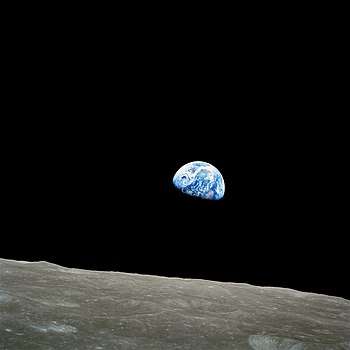



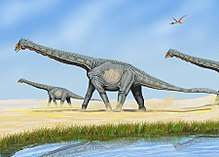

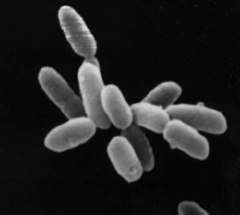

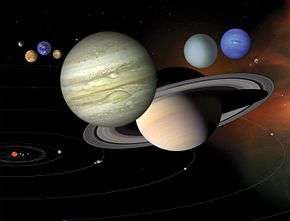
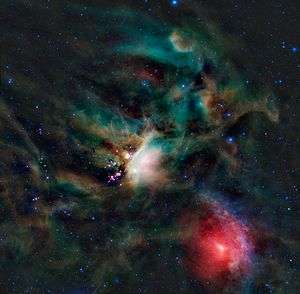
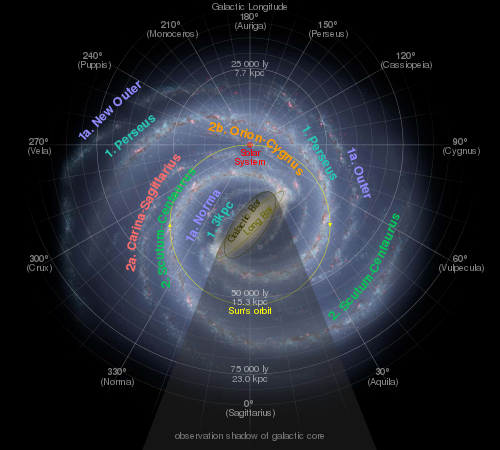
.jpg)
